April 29, 2011
Anne Sofie von Otter, Wigmore Hall
After the exuberant, high-spirited performance of Magdelena Kožená and Private Musicke in March, Anne Sofie von Otter, accompanied by Cappella Mediterranea, presented a more restrained account, delivering a powerful, controlled expression of love and grief.
We began with a sequence of numbers from Monteverdi’s tale of faithful endurance, Il ritorno d’Ulisse. The dark, resonant bass registers of the opening Sinfonia, as the members of the Cappella, led by Leonardo Garcia Alarcón at the organ, skilfully improvised on what the score presents as a simple minor chord, aptly conveying Penelope’s distress and anguish as she waits languidly for the return of the eponymous hero. Von Otter remained seated at the commencement of ‘Di misera regina’ (‘The queen’s misery’), her grief subdued, the soft-focused, flexible melodic line revealing her weariness and quiet despair. Rising to stand for the more declamatory text, as the queen angrily accuses Ulisse of neglect, even betrayal, von Otter injected a bitterness into the recitative, complemented by the astringent tone of Gustavo Gargiulo’s cornett. The heavy, portentous organ suggested that Penelope may be right in her fears that her fate shall ‘never alter’; here, and throughout the recital, Alarcón was eager to give every textual nuance a musical shade, although I found the organ timbre a little too grave and sombre, and welcomed the light fleetness of the final section, ‘Torna il tranquillo al mare’ (‘Calm returns the sea’) during which the organ was silent.
Von Otter’s Italian was crystal clear, but the Camerata proved just as adept at communicating textual meaning. For, the sequence concluded with an instrumental interpretation of the returning sailors’ Act 1 song, in which they celebrate man’s power and freedom in the face of the indifference of the gods. The players’ ornaments and figurations responded expertly to the text, conveying energy and swiftness, driving forward through an exciting sequence of rising modulations.
In Barbara Strozzi’s ‘Che si può fare’ (‘What can one do’), von Otter was once again surprisingly restrained, remaining seated for this monumental lament, but she demonstrated an effortlessly lyrical beauty in the tender melismas, delicately and poignantly contrasting with some startling harmonic dissonances. A deeply intense sentiment was conveyed, enhanced by a spirited dialogue between the two violins and the marvellous realisation – expressive, intricate but never overwhelming – of the repeating ground bass by theorbo player, Daniel Zapico.
‘Sí dolce è’l tormento’ (‘So sweet is the anguish’) by Monteverdi followed, revealing the rich, burnished quality of von Otter’s lower range. She ventured a daringly hushed pianissimo and rubato in the closing lines, conveying the paradoxical ‘sweetness’ of her anguish: ‘Su, su prendi arco e faretra,/ Casto amore, e ‘l cor mi spetra’ (‘quickly, take your bow and quiver,/ chaste love, and melt my heart’).
Francesco Provenzale was one of the leading figures in the musical life of Naples during the seventeenth century. ‘Squarciato appena havea’, conventionally attributed to him, is a lament-cantata in the Roman style with seven popular songs breaking in at unusual points in the sequence of sections in a recitative style. It is a satire of Luigi Rossi’s famous cantata, ‘Un ferito cavaliero’, which tells the story of the death of Gustavus Aldophus, husband of Queen Christina of Sweden in Lünzen in 1632. The Queen seems to die at the end of each strophe, and the purpose of inserting popular songs which interrupt the lamenting recitative, seems to be to create paradoxical contrast; for the songs are children’s ditties and lullabies, well-known repertory for voice and guitar from the seventeenth-century. Von Otter relished the ironies, exaggerating the emotions – at times introducing a rough grain to her voice to contrast with more lyrical outbursts, elsewhere emphasising the remarkable chromatic inflections. Her rhetoricism and theatricality was complemented by the musicians, a melodramatic organ tremolo underpinning the Queen’s grief-stricken exclamation, ‘Il mio Gustavo è morto?’ (‘Is my Gustavus dead?’). Zapico’s ornamentation of the phrase, ‘Onde morta ed esangue la Regina’ (‘When the Queen is dead and lifeless’) was masterful, evoking a remarkable still languor. Von Otter even turned instrumentalist herself, shaking and striking a tambourine, stamping and clapping energetically to the sprung, syncopated rhythms.
While there was no doubting the sincerity of the musicians, and their delight in the material, or Von Otter’s expressive involvement, the first half of this recital did not quite tap the spirit of joie de vivre and impassioned emotion that these songs embody. She certainly inhabited the dramatic personae of the lyrics, but von Otter did not seem entirely at ease. Despite the swaying and clapping, a certain sense of freedom, even recklessness, which is elemental in these songs was absent – her invitation to the audience to join her in her percussive accompaniment to the final song was not heeded. In the instrumental numbers, von Otter stayed seated centre-stage, the focus of the audience’s eye, and perhaps this inhibited the musical brio of the performers. At times Alarcón’s vigorous direction of the ensemble seemed a little too effortful. Moreover, even allowing for the instability of these authentic instruments, there was an awful lot of tuning and re-tuning, at the start of each half of the recital, and between numbers, and this (together with an extremely long interval) hindered the creation of musical momentum and over-arching dramatic shape.
In the second half we moved gradually from Italy, through France, to England. Over the same chaconne bass previously heard in Strozzi’s aria, the instrumentalists interpreted the text of ‘Mio ben, teco il tomento’ (‘My beloved’) by Rossi, which led into Marc-Antoine Charpentier’s ‘Quel prix de mon amour’ from Médée. This is a beautiful account of the pain wrought by infidelity, and von Otter expertly conveyed Medea’s anguish, exploiting the poignant cadential appoggiaturas and fluctuating tempo to powerful expressive effect.
Some superb cornett and violin playing in an instrumental rendering of Ariel’s ‘Dry those eyes’ from The Tempest, by John Weldon, was followed by the vocal flourishes of Henry Purcell’s short recitative ‘Hark! how all things’ (from The Fairy Queen) and the diverse colours, textures and tempi of ‘From silent shades’, in which the distracted snatches of the songs of ‘Bess of Bedlam’ are presented in a mixture of popular and classical idioms. As in Provenzale’s cantata, von Otter enjoyed the dramatic and unconventional aspects of this song, playfully delivering the occasionally unaccompanied text: the juxtaposition of the painful chromaticism of Bess’s self-pity, ‘Cold and hungry am I grown’, with a headlong, joyful carelessness, ‘Ambrosia will I feed upon’, forcefully conveyed the protagonist’s instability and insanity.
Two arias by Handel, separated by an instrumental passacaglia, brought the recital to a close. In ‘Where’er you walk’ from Semele and ‘Ogni vento’ from Agrippina, von Otter showed her mastery of the opera seria idiom, wonderfully shaping the melodic line during the first statement of the text, subtly ornamenting and elaborating on its return. The audience response was ecstatic. But, despite the unquestionable technical and musical talents on display, I felt that at times during the evening the performance lacked the natural exuberance and unrestrained liberty that this music requires and inspires.
Claire Seymour
image=http://www.operatoday.com/Anne_Sofie_Von_Otter_%282175%29.gif image_description=Anne Sofie von Otter [Photo by Mats Bäcker] product=yes product_title=Anne Sofie von Otter, Wigmore Hall product_by=Anne Sofie von Otter. mezzo-soprano. Cappella Mediterranea. Leonardo Garcia Alarcón: director, harpsichord, keyboard. Gustavo Gargiulo, cornet; Boris Begelman, violin; Stéphnie de Failly, violin; Andrea De Carlo, viola da gamba; Daniel Zapico, theorbo. Wigmore Hall, London, Thursday, 21 April 2011. product_id=Above: Anne Sofie von Otter [Photo by Mats Bäcker]Rigoletto, New York
Each melody is lovely in itself (except, perhaps, for the court dances of the first scene, which are supposed to seem shallow in any case, and do), but more important each one fulfills its dramatic moment and enhances our understanding of the character who sings it. The dramatic movement is steady and inexorable—and pitiless. Step by step, each important element of the drama takes place before our eyes—nothing is concealed except the Duke’s rape of Gilda, and in some modern stagings we even get to watch that. But the current Met production, thank heavens, designed by Otto Schenk and somewhat vulgarly directed by Gregory Keller, happily spares us that particular debauch. It is a handsome, old-fashioned job, with fine architectural elements and a street in medieval Mantua that, damn it, looks like a street in medieval Mantua. The costumes are rich and attractive. It does the job.
Its third cast this season gave signs, on April 26, of insufficient rehearsal time. This was most clear in Fabio Luisi’s conducting, which throughout the first scene and on several other occasions (notably the murderers’ trio in Act III) raced along far too swiftly for the ability or the experience of the singers. Luisi just didn’t seem to be giving a thought to their vocal situations; a link that should go both ways was only open in one direction. It is not necessary for a conductor to follow his singers, but a certain degree of interaction, of appreciation of the way they are handling their roles and when they are in difficulties, is something one can hope for of a conductor leading a repertory opera of this familiarity.
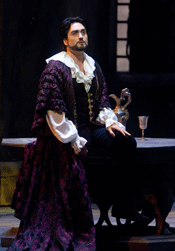 Giuseppe Filianoti as the Duke
Giuseppe Filianoti as the Duke
The three leading singers all have excellent reputations to which they all, in part, lived up—the performance hit somewhere around the A-minus, B-plus range. How would this cast sound in a smaller theater, or in a studio with a more relaxed atmosphere? I suspect they’d all have done better.
Željko Lučić has one of the Met’s most beautiful baritone voices just now, but he occasionally sang flat just when one wanted to relax and enjoy it. Still: His “Cortigiani, vil razza” was a jeweled display of Verdi singing, elegantly produced. One might not have noticed, however, that this is a passionate aria, sung in an extreme situation. As an actor, Lučić has much to learn, and the Met might with profit bestir itself to teach him, and not merely how to sing a make-or-break aria with the proper intensity. For one thing, Rigoletto’s hump is not a figure of speech—he’s supposed to be visibly crippled, to have lived all his life with taunts and ill treatment for his condition, to have turned against the human race for this very reason. To stand sturdily upright while those around you mime a cripple to insult you is to miss a big point, and yet this was Lučić’s attitude all night. (His Barnaba in Gioconda omitted personality in the same way.) His joking in Act I lacked point or fury, his behavior in Act II lacked pathos. The courtiers did not toss him about, either—he never seriously tried to break through. One could admire the vocalism; one was never inspired to weep or cringe at the tragic figure. Rigoletto is one of the supreme roles of the baritone repertory; I hope Lučić, who sings it so well, will coach it with someone knowledgeable, or undertake a production with a really inspiring director.
Diana Damrau, in contrast to Mr. Lučić, can act a role and does. She’s studied the libretto as well as she’s studied the music, and she lived every shade of it: Girlish with her father, alarmed and then yielding when alone with her suitor, embarrassed and terrified by the crowd of strange men in Act II, unable to tear her unhappy eyes away, in Act III, from the Duke’s seduction of Maddalena. Her singing, too, was entirely at the service of her dramatic conception—there were vocal fadeouts, muddinesses, thinnesses that I suspect would not have been heard in a rehearsal, the product of her concentration on being Gilda. It was possible to enjoy her “Caro nome” without noticing it was—had ever been—a famous coloratura showpiece, for she made its breathless phrases an expression of girlish ecstasy. She took none of the role’s optional high E’s—which Verdi did not compose—but she also omitted the trills, which he did. Those accustomed to more power at such moments as “Si, vendetta” might also have been disappointed.
Where Rigoletto should be (but Lučić wasn’t) busy, uneasy, concocting and reflecting, the Duke should be graceful, sensuous, at home in his vicious element. Giuseppe Filianoti was a Duke who could not sit still. His pleasing tenor was all over the place, heavily stressed in the first scene, suave and pleasing in the seduction duet, hoarse in the quartet (where the direction demanded far too much activity to permit high notes), and cracking unattractively in his post-coital encore of “La donna è mobile.” He basked in his own and the audience’s affection, so that it was easy to think him a ladies’ man, more difficult to see him as the self-indulgent daydreamer of “Parmi veder.” He often ended phrases with a serene high note, only to be brought up breathlessly short. Was it the unaccommodating conductor or a graceless vision of the part that gave him pause?
One of the most impressive things I’ve ever beheld on any stage was the sight of Ruggiero Raimondi as Sparafucile, singing his lines while holding, over his shoulder, a sack containing Joan Sutherland. After he sang (and he sang well), he slid the sack ever so gently to the floor, where Sherrill Milnes did not even try to lift it, but hauled it to center stage, kicked it a few times, and—out popped Joanie, trilling away! At the next performance I attended, Ivo Vinco did not attempt to carry the sack—an assistant ruffian stood behind him to hold it. Sparafucile in this latest Rigoletto was Stefan Kocán, who sang decently and looked very sporty (hired assassins outdress courtiers in this Mantua, evidently), but whose threats I cannot take seriously—an assassin who needs an assistant to help carry petite Diana Damrau can’t be much good at his job. Kathryn Day, the substitute Giovanna, sang her few phrases with lovely clarity. Someone has told Quinn Kelsey, the Monterone, that this is the Jonathan Miller production set in Little Italy; he sings well but his moves and gestures are those of a low-class Sicilian thug. Monterone is a gentleman at a ducal court and should behave with outraged dignity, a very different thing, at least on the stage.
John Yohalem
image=http://www.operatoday.com/Rigoletto-Met-2011-01.gif image_description=Zeljko Lucic in the title role and Diana Damrau as Gilda [Photo by Marty Sohl courtesy of The Metropolitan Opera] product=yes product_title=Giuseppe Verdi: Rigoletto product_by=Rigoletto: Željko Lučić; Gilda: Diana Damrau; Duke of Mantua: Giuseppe Filianoti; Sparafucile: Stefan Kocán; Monterone: Quinn Kelsey. Metropolitan Opera Chorus and Orchestra conducted by Fabio Luisi. Performance of April 26. product_id=Above: Željko Lučić in the title role and Diana Damrau as GildaPhotos by Marty Sohl courtesy of The Metropolitan Opera
Séance on a Wet Afternoon
But, despite what you may have read, Stephen Schwartz’s new opera is far from all wet. In fact, last weekend’s matinee at the David H. Koch Theatre was as much a success as it was a séance. NYCO’s East Coast premiere production of Séance on a Wet Afternoon, based upon the novel by Mark McShane, epitomizes what the company stands for and points towards what opera in America can be. The staging is smart and engaging, the music is used to forward the drama, the singers are equally talented as actors and musicians, and the result is both emotionally satisfying and thought-provoking. So why, when there are $12 tickets available, are there empty seats?
For opera lovers, there is plenty to enjoy— pathos, demanding vocalism, and lush orchestration unlike what you would find on a Broadway stage. The music is accessible (yes, perhaps overly so), the acting polished, and the show definitely benefits from its Broadway pedigree. Whatever your proclivities or demographic, this art is meaningful and relevant, and it should not be missed.
Together, father and son team Stephen and Scott Schwartz (acting as composer/librettist and director, respectively) have created a compelling theatrical event. From the moment the curtain rises during the highly cinematic overture to reveal a stage hung with black metal chains, the audience is swept along in suspense by the music and drama (thanks, in large part, to the efforts of conductor George Manahan). Much of the first act takes place inside the home of the Bill and Myra Foster, and Heidi Ettinger’s set struck an ideal balance between an appropriately prosaic environment for the domestic drama and a space where uncanny things can happen. The transparent walls suffuse with color and light, then disappear altogether, and the audience’s perspective on the drama is allowed to shift as the house itself rotates.
As Myra and Bill Foster, a couple who conspires to kidnap a child in order to boost Myra’s career as a medium, Lauren Flanigan and Kim Josephson are ideally matched to both the material itself and to each other. It should come as no surprise that Flanigan excels here— she is a NYCO veteran and a powerhouse singing-actress. Kim Josephson, in his NYCO debut, matches her intensity and makes good use of the opera’s best material. Melody Moore, in the role of the kidnapped child’s mother, stands out as well. Were this production mounted on Broadway, Ms. Moore would undoubtedly be nominated for a Tony award. She meets every vocal and dramatic challenge and breathes life and individuality into a role which could easily be reduced to a trite stereotype. As with Mr. Josephson, Ms. Moore is making her company debut with this production and both artists exemplify the company’s success in its mission to bring compelling performances of new works to New York City audiences. Unfortunately, as Charles Clayton, tenor Todd Wilander did not live up to the standard set by his partner. He was vocally cautious and played every obvious emotion rather than establishing a connection with his excellent partner.
As a quartet of Myra Foster’s regular clients, Jane Shaulis, Pamela Jones, Doug Purcell, and Boyd Schlaefer played their individual parts with plenty of verve and worked well as an ensemble. Phillip Boykin brought vocal and physical gravitas to his role as the Inspector. The two children in the cast, Michael Kepler Meo and Bailey Grey, are both veterans on the stage and their performances were on par with their adult cohorts. The chorus of reporters was well-rehearsed by both chorus master Charles F. Prestinari and choreographer Matt Williams, but their material was largely irrelevant and repetitive.
As previously mentioned, this production is not without flaws. Inevitably, the singing is not as good as one would hear at the Metropolitan Opera next door, nor is the diction as good as that heard on Broadway. While there are many effective bits of theatrical magic (including bodies coming together to form a streetcar and a black-and-white portrait that gains color during an emotional aria), the overall drama of the piece is often undermined by Schwartz’s own libretto. For the most part, every bit of suspense in the plot is used to maximum effect but the scene in which Myra is in the room when the kidnapper (his own husband) calls the Claytons falls flat. Furthermore, Myra’s aria at the top of the second act hardly serves to develop the drama, the music, or her character and it could easily be cut.
All in all, Séance on a Wet Afternoon is an exciting opera to watch, not only because of the suspenseful plot, but also because it speaks to the future of opera in America. Yes, the music lacks complexity but, just as not every movie is made to win an Academy Award, not every opera is meant to stand up to repeated listening. Séance is not an opera for the future in the sense that it will remain in the repertoire forever. Rather, the work itself and the quality of this production speak to a democratization of opera itself and the encouraging trend that, finally, American artists are adopting the genre as their own.
Alison Moritz
image=http://www.operatoday.com/Stephen_Schwartz.gif image_description=Stephen Schwartz [Photo courtesy of Wikipedia] product=yes product_title=Stephen Schwartz: Séance on a Wet Afternoon product_by=Click here for the cast list and other information relating to this production product_id=Above: Stephen Schwartz [Photo courtesy of Wikipedia]April 24, 2011
Sumeida’s Song
That would certainly calm a lot of people down at any rate. The Arabs, for example. They’ve grown understandably restive about the way their societies have been run lately, and with their capacity for narration (1001 Nights, anybody?) and distinctive musical heritage, opera ought to be a natural for them. The more cosmopolitan cities of the Arab world have developed a rich theatrical scene in the last century, and their films and music-videos imply the cultural jump would not be an awkward one. There’s a kebab-and-hookah restaurant near me that shows Egyptian music-videos from the early Nasser years, or so I infer by the length of the ladies’ skirts. But we’ll have to be quick before Arab culture is swamped (as youtube is already swamped) with Bollywood-style Arabic videos, of which Lebanon already produces quite a trove.
Mohammed Fairouz, who is 26 and was educated in London (his biography in the program is cagey about where exactly he was born), has already prowled much of the planet, studying instruments from the oud to the didgeridoo, though the Mimesis Orchestra that played the premiere of his opera, Sumeida’s Song, in the hall of the Ethical Culture Society last week was made up of traditional Western instruments with some enhanced percussion. The use to which Fairouz put this orchestra demonstrates an impressive control of the varied textures it can produce. He was careful—perhaps unduly so—to avoid the trap of relying on “Middle Eastern” motifs in “Western” orchestration, which could have sounded like Hollywood’s scores for Arabian Nights movies of the fifties, but he introduced a phrase or two of Middle Eastern-style drumbeat or oboe riff into a manner more typical of spiky modern borderline tonalities. Middle Eastern-isms have been explored in considerably greater detail in John Corigliano’s wind concerti, but that is the very sentimentality that Fairouz evades.
The character of the score across three brief acts (about eighty minutes) gave every section of the orchestra something interesting to do. Percussion, as is true with so many modernist works, was full of interest, but the beats were not for dancing: Rather, they illustrated references in the text to winds, to vendetta, to railroads. Woodwinds did not mimic Arabian lament but underlined phrases in the drama. Thunderous low brasses accompanied deadly events in an international manner. Yet this very avoidance of anything specifically “Arabian” may have been a mistake: The most affecting moment of the score, for me, was the last wail of an implacable mother: The soprano’s voice, shifting through semitones, seemed to imply a mixture of traditional keening with an uncertainty about her bloodthirst and its consequences that went well with the fading, uneasy tremolos of the last bars of the opera and encapsulates the moral of the story.
All this expert orchestration was, unfortunately, not matched by any gift for libretto-writing. The story, taken without alteration from a classic play by the modern Egyptian writer Tawfiq al-Hakim, concerns the widowed Asakir, whom we find awaiting her son’s return from the big city. When his father was murdered by a rival clan, she smuggled the boy to Cairo, hoping he’d apprentice to a butcher—in order to learn to use a knife properly. Instead, he went to college and realized how his rural people have been oppressed. He is 19 now, a modern man who refuses to consider vendetta—he’d rather organize the people to improve their dreary lives. His mother, outraged, taunts one of his cousins into killing her disgrace of a son. The cousin is Sumeida, whose song, sung twice, signifies first Alwan’s return, then his death.
There are possibilities here, for a librettist of genius, but in the unaltered play that constitutes the libretto it is rather ploddingly told. It is difficult not to recall such similarly brutal and elemental stories as those of Cavalleria Rusticana or Tosca, and how cleverly their librettists slid back-story into dramatic event. In Sumeida’s Song, everything is explained at the moment it is said, and none of the music carries us, holds us melodically, or builds to a satisfying explosion. In eschewing melodramatic music in a melodramatic tale, Fairouz, like most modern composers, really has nowhere to turn. His intriguing orchestration is accompaniment, whereas in opera the music should share the dramatic propulsion. It is not good being told (as the libretto told us, at several moments) that someone is performing an aria; either we feel it as an aria, as a statement, as an expression of inner feeling, or we do not. These arias were indistinguishable from the explicatory dialogue.
Fairouz’s vocal writing seemed either ungrateful, exploring the extremes of his prima donna’s range in both directions, or else Jo Ellen Miller as the murderous Asakir simply wasn’t up to it. Inaudible in the first act, she pulled some dignified phrases out at as the drama proceeded. None of the other singers had a fully-formed character to portray, and all were easily drowned out when the orchestra roused itself, though the composer politely restrained them whenever some special lyrical message needed to be expressed.
Fairouz demonstrated genuine ability and achievement as an orchestral technician, and he may well have more to offer singers with a more focused text (he has composed ten song cycles), but nothing about Sumeida’s Song suggested a mature affinity for opera.
John Yohalem
image=http://www.operatoday.com/Fairouz.gif image_description=Mohammed Fairouz [Photo courtesy of composer] product=yes product_title=Mohammed Fairouz: Sumeida’s Song product_by=Mabrouka: Rachel Calloway; Asakir: Jo Ellen Miller; Sumeida: Robert Anthony Mack; Alwan: Randall Scarlata. Mimesis Orchestra, conducted by Scott Dunn. Ethical Culture Society, performance of April 13. product_id=Above: Mohammed Fairouz [Photo courtesy of composer]April 22, 2011
Salome, Grosses Festspielhaus, Salzburg Easter Festival
By Shirley Apthorp [Financial Times, 22 April 2011]
A gigantic moon, symbol of obsession, gazes out at the audience of this year’s Salzburg Easter Festival. Literally. Some way into the action, a series of eyes open and blink back at us from between lunar craters. As we watch, we are seen.
The Magic Flute, Manitoba
Manitoba Opera’s production of this three-hour masterpiece offered a bonus feature: a crackerjack cast rich with talented Manitobans working their own special magic. Twelve out of 15 roles were filled by Manitoba singers.
The opera’s set, representing 1882 Egypt, was a stark multi-level structure resembling stone. Creative curtain draping, props dropping from above and a brightly lit pyramid made for efficient, if slight, scene changes.
As Tadeusz Biernacki conducted the Winnipeg Symphony Orchestra through the overture, we were treated to some inventive effects — characters silhouetted high against a red sky, watching as an Anglo-Egyptian War battle raged below making explosions of light. Bill Williams’ lighting introduced the story before a single note was sung.
We first see American lyric tenor Bruce Sledge (Tamino), struggling to escape a huge, Chinese dragon-like serpent, with billowy cloth body, gigantic googly-eyed head with fangs. He was saved by three hilariously preening ladies, played to the hilt by sopranos Sarah Halmarson and Naomi Forman and smoky-voiced mezzo Marcia Whitehead. Coiffed in multi-coloured streaks, they fawned competitively over the collapsed Tamino, making clever (and suggestive) choreographic use of the crooked poles they carried.
Sledge has a true hero’s voice and demeanour. In “Dies Bildnis ist bezaurbernd schön,” he poured his heart into his singing, flowing phrases imbued with passion. He also did a mean representation of flute-playing, making it quite believable.
One of opera’s all-time favourite characters, bird-catcher Papageno was played by baritone Hugh Russell. Dressed in feathers and rags, he was delightfully animated, his easy, pleasing voice setting just the right tone for this amiable role. Russell is the ideal Papageno, with great comic ability and superb timing.
While the opera was sung in German, all dialogue (by Schikaneder) was in English, so the audience could laugh along with Papageno when he spouted such gems as “all this stress is making me moult out of season” and claimed that the wine was giving him “acid reflux.” Director Michael Cavanagh went to town with the dialogue, giving us plenty of chuckles.
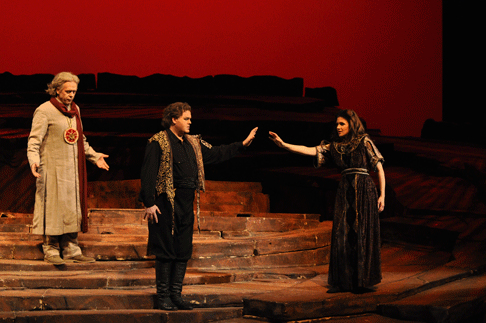 Phillip Ens (Sarastro), Bruce Sledge (Tamino), and Andriana Chuchman (Pamina). [Photo: R. Tinker]
Phillip Ens (Sarastro), Bruce Sledge (Tamino), and Andriana Chuchman (Pamina). [Photo: R. Tinker]
Papageno’s better half, Papagena, was the delightful Lara Ciekewicz. She was positively bubbly in this small role. Their “Pa-pa-pa-gena! Pa-pa-pageno!” was lively and adorable.
Speaking of adorable, who couldn’t love the three genii with their bushy white hair and angelic voices? Bravo to Carson Milberg, Anton Dahl Sokalski and Torbjörn Thomson.
As the infamous Queen of the Night, American coloratura Julia Kogan made quite the entrance, floating down from the sky on a fantastical winged camel. Dressed in a magnificent gown, she was ghostly pale — but her fine voice was anything but. Assertive and commanding, she ordered Tamino to rescue her daughter Pamina. But in later scenes, Kogan’s dialogue was almost inaudible upstage. She made a valiant effort in the devilishly difficult “Der Höle Rachekocht in meinem Herzen,” reaching for the highest notes with obvious exertion.
Winnipeg soprano Andriana Chuchman’s Pamina was radiantly princess-like, with an appealing dose of youthful exuberance. Chuchman is a natural performer, with a mature, substantial voice that carries exceedingly well. The famous lament, “Ach, ich fühl’s, es ist verschwunden” was masterfully crafted, round notes oozing heartbreak.
Phillip Ens’ resonant bass made the ultimate High Priest Sarastro, steady and noble. The depth and pomp of his performance made every hair stand on end. His regal robes were elegant and refined.
His slave Monostatos, played by the athletic Michel Corbeil, appeared tattooed from the top of his bald head to his toes. His flexible tenor voice sneered through his lines, making him the villain we loved to hate.
Gregory Atkinson was perfectly cast as an authority figure (High Priest), his deep voice richly resplendent. PJ Buchan’s (Priest) glorious tenor voice sounds better on every outing.
The chorus rounded out the production nicely, always well balanced and supportive. Kudos go to the orchestra, in particular for the many solos by flute and glockenspiel. There would be no Magic Flute without them.
This was a first-rate production in every way.
Gwenda Nemerofsky
image= image_description= product=yes product_title=W. A. Mozart: The Magic Flute product_by=Manitoba Opera, Centennial Concert Hall, April 9, 2011 product_id=Minnesota Opera rescues Herrmann work
That’s the case at least in the Minnesota Opera’s mesmerizing production of the largely forgotten work that opened at St. Paul’s Ordway Center on April 16. Herrmann’s score, completed in neighboring Minneapolis in 1951, is Romanticism writ large and saturated with Weltschmerz. And it all hurts so good!
With the help of librettist — and first wife — Lucille Fletcher Herrmann took much of the agony — but none of the angst — out of Emily Brontë’s 1847 novel. It is now a gentler story; they have softened the narrative line and made these forlorn credible in their passions — and their frustrations. The frame of the 19th-century social novel is still there, but these are people who would have a hard time building meaningful relationships even without the barriers of caste. To make this clear, MO assembled a great production team for a staging that — one hopes — will be seen on other companies.
Only someone with a heart of stone could resist loving Heathcliff as played by Lee Poulis, a Hollywood-handsome baritone who must be spectacular Don Giovanni, a role he has played at Sarasota Opera. He’s moody, to be sure, but Simonson does not place great emphasis on Heathcliff’s origins as a Gypsy foundling taken into the stuffy and inhibited Earnshaw family. And his problems are explained only in part by the social structure of the day. Poulis shrouds him in darkness — that’s what makes him fascinating to women (and at some point in the past to the elder Earnshaw who brought him home from Liverpool).
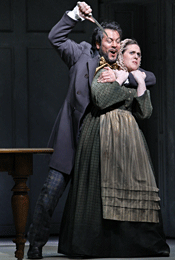 Ben Wager as Hindley Earnshaw and Victoria Vargas as Nelly Dean
Ben Wager as Hindley Earnshaw and Victoria Vargas as Nelly Dean
It’s clear that Heathcliff is an unlikely candidate for an enduring Mr. Right in any era. He’s a complex guy — even when “sanitized” and gussied up in fancy duds. (How he comes to wealth so suddenly is left a secret by Brontë.) Thus it’s unavoidable that Catherine Earnshaw will love Heathcliff even after her marriage to colorless Edgar Litton, and that there’s no way out of this dilemma for her.
As Catherine Sara Jakubiac replaced Kelly Kaduce, originally slated to sing the role. Although she might not yet have Kaduce’s polish, Jakubiac may have an even richer and larger voice than Kaduce, the MO favorite who returns to the company as Madama Butterfly next season. Jakubiac made the long solo scene in which Catherine faces the hopelessness of her situation both gripping and engaging.
Equally touching was mezzo Adriana Zabala in writing the confessional letter that leaves no doubt about the miseries of her life with Hindley Earnshaw, sung by bass Ben Wager. Wager, on the other hand, somewhat overplays his addiction to alcohol in a scene that breaks with the overall resolute calm of Herrmann’s score.
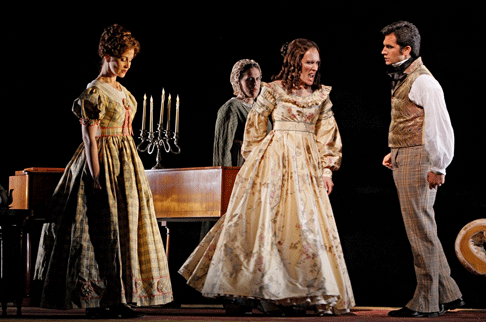 Adriana Zabala as Isabella Linton, Victoria Vargas as Nelly Dean, Sara Jakubiak as Catherine Earnshaw and Eric Margiore as Edgar Linton
Adriana Zabala as Isabella Linton, Victoria Vargas as Nelly Dean, Sara Jakubiak as Catherine Earnshaw and Eric Margiore as Edgar Linton
It’s a pity that as Edgar, Eric Margiore, the only tenor in the cast, has so little to sing. His one aria was lovingly delivered.
Although the part is small, bass-baritone Rodolfo Nieto brought one of the strongest voices in the cast to farmhand — and religious fanatic — Joseph.
One wishes one might have heard more of Jesse Blumberg — one of America’s great young baritones and a MO regular — than was allotted him as Mr. Lockwood in the opening scene.
Herrmann — most famous for such film scores as Citizen Cane and Psycho —otherwise spent his life largely as a conductor. It is not surprising, then, that Wuthering Heights is in concept orchestral, and in Michael Christie MO chose a conductor who knew how to make the most of this fact. Punctuated by many solo moments, Wuthering Heights as drama is essentially through-composed, in light of which Christie kept a sensitive finger on the pulse of the score.
Despite a staging at Portland in 1981 and a concert performance in France last summer, Wuthering Heights has never found its way into the repertory, because — allegedly — Herrmann was offended by any suggestion that he shorten the 3.5 hour work. That the MO performance lasted less than three hours seems to indicate that significant cuts were made in this production. Despite the length of the performance Christie kept attention riveted on the opera.
The sets and costumes by Neil Patel and Jane Greenwood, respectively, were predictable, Wendall K. Harrington brought visual enchantment to the production with the projections of which she now seems the national master. (She was equally successful with her contribution to Ricky Ian Gordon’s Rappahannock County, premiered at the Virginia Arts Festival on April 12.)
This production is part of Minnesota’s New Works Initiative, designed to focus attention on new or neglected work. A “first” for the company, the staging will be filmed in high definitive for digital distribution. (Confession: I set out to read Brontë’s novel for the first time in 65 years, but put it aside half way through. Herrmann’s version of the story is far better entertainment.) Dates for broadcasts and showing have not been set at this time.
Wes Blomster
image=http://www.operatoday.com/0519.gif image_description=Sara Jakubiak as Catherine Earnshaw and Lee Poulis as Heathcliff [Photo by Michal Daniel courtesy of Minnesota Opera] product=yes product_title=Bernard Herrmann: Wuthering Heights product_by=Catherine Earnshaw: Sara Jakubiac; Heathcliff: Lee Poulis; Hindley Earnshaw: Ben Wager; Edgar Linton: Eric Margiore; Isabella Linton: Adriana Zabala; Nelly Dean: Victoria Vargas; Joseph: Rodolfo Nieto; Mr. Lockwood: Jesse Blumberg; Hareton: Joshua Ross. Dancers: Jeremy Bensussan, Megan McClellan. Conductor: Michael Christie; stage director: Eric Simonson; Choreographer: Heidi Spesard-Noble; Set designer: Neil Patel; Costume designer: Jane Greenwood; Projection designer: Wendall K. Harrington. Minnesota Opera, Ordway Center, St. Paul, April 16, 2011. product_id=Above: Sara Jakubiak as Catherine Earnshaw and Lee Poulis as HeathcliffAll photos by Michal Daniel courtesy of Minnesota Opera
Otello, Carnegie Hall
This makes the score one of particular delight to an instrument as skilled and as superbly led as the Chicago Symphony Orchestra (and its equally illustrious chorus), and the opera’s appeal clear to its director, Riccardo Muti, a former music director of La Scala.
When, at sixteen, I told my father that I had discovered opera, he got me my first opera recording: the von Karajan Otello with Del Monaco and Tebaldi, both singers considered definitive interpreters of the roles at that time. (In the Rome Opera House, there is a wall-size bronze plaque dedicated to Del Monaco, with his profile and the bar lines for Otello’s opening “Esultate…,” a terrific way to remember a tenor, eh?) I listened to this first recording devoutly, and then encountered the opera in performance in perhaps Franco Zeffirelli’s finest bit of stagecraft at the Met, under Böhm, with Zylis-Gara, Vickers and Milnes singing and acting it superbly. And there have been many great Otellos for me since then (McCracken, Domingo, King, the frighteningly quiet Willow Song of Pilar Lorengar, the horrifying Iago of Wassily Janulako), but there were things in the orchestration that I had not noticed until the Chicago’s performance before a packed Carnegie Hall last Friday. This points up one of two advantages about a concert performance of an opera (the first being that no stage director to distract you from the piece being performed with his own irrelevance): You can hear the orchestra more clearly, often playing with more care, than you can in the opera house, where there is a covered pit and the distractions of the stage and the attention (and the limelight) squarely on the singers.
Riccardo Muti, who has conducted hardly any opera in this country, got his start in the opera house and his original fame as a stickler for the letter of the score. This has led to many productions of operas of an earlier era that aficionados deplore as lacking the high spirits that idiosyncratic singers (of the best sort) could bring to them. Muti’s attention to detail, to the symphonic picture and to dramatic propulsion suits some operas better than others, and Otello is a case where the composer knew just what he wanted and took infinite pains to achieve it. Muti has great fun with it, reaching out to each section with clutching, pleading hands, wooing them into the dynamic he desired. There were times during the lighter, merrier moments with which Verdi intended the dark drama to be studded—the drinking song, the “flower” chorus, the “handkerchief” trio in Act III—that an airier spirit sometimes eluded his attention, but placing the Chicago Symphony in the hands of such a technician produces gilded, glowing effect upon effect, each tremolo wind in perfect tune (from sighing violins to threatening, murmurous basses), each thunderous brass outburst ideally calculated.
The singers, all well chosen, were not in quite such superlative form as the orchestra and chorus. Aleksandrs Antonenko, singing though ailing, in Italian rather better than his French in last year’s Les Troyens at the same hall, demonstrated real tenor ping (as the aficionados say) on Otello’s abrupt rises from the conversational to the furious and was never overwhelmed by the orchestra. His quieter, more tragic moments were affecting as well. Krassimira Stoyanova, who has sung Desdemona to acclaim from Vienna to Barcelona, was occasionally flat in the Act I love duet, but her placid, dignified bewilderment in the rest of the opera was true and sweet, her Willow Song and Ave Maria quietly devastating. Carlo Guelfi, not always the most exciting of baritones, sang a worthy, menacing Iago, with diabolic energy to his cries of “O gioia!” as his wicked plots moved to fruition. Juan Francisco Gatell’s Cassio and the few (but full and lovely) notes of Barbara Di Castri’s Emilia made one eager to hear more of their singing. Only Eric Owens, the growling Lodovico, proved a disappointment.
John Yohalem
image=http://www.operatoday.com/Muti.gif image_description=Riccardo Muti product=yes product_title=Giuseppe Verdi: Otello product_by=Otello: Aleksandrs Antonenko; Desdemona: Krassimira Stoyanova; Iago: Carlo Guelfi; Emilia: Barbara Di Castri; Cassio: Juan Francisco Gatell; Rodrigo: Michael Spyres; Lodovico: Eric Owens. Chicago Symphony Orchestra and Chorus, conducted by Riccardo Muti. At Carnegie Hall, April 15. product_id=Above: Riccardo MutiCyrano, Florida Grand Opera
A ready smile that often gives way to laughter, a simple though intense curiosity, an ease in interrelating, all superimposed over a seriousness of purpose — these are David DiChiera’s communication arsenal. It could be said that these selfsame traits reside within one Cyrano De Bergerac, the uber-nosed gentleman swordsman of France and the protagonist in DiChiera’s opera. It could also be said that parts of Cyrano’s character reside within us all.
Side by side in the rehearsal hall inside the Adrienne Arsht Performing Arts Center in Miami sit DiChiera, stage director Bernard Uzan, and conductor Mark D. Flint. It is the second shift of rehearsals for the day of the scene that leads into Cyrano’s quintet. Florida Grand Opera’s production of the composer’s Cyrano opens here on April 23. Marian Pop, Leah Hunt Partridge, Sebastian Gueze, Peter Volpe and Aaron St. Clair Nicholson are present. In the relaxed atmosphere, Uzan and singers are at work hashing out scene details as Dr. DiChiera — whose other titles include music scholar, impresario, and community-activist — follows along in the score.
“It began with Bernard. He was music director in Detroit.” DiChiera returns to when his Cyrano first took shape. “I think your music would be wonderful for my favorite story.” Hearing DiChiera tell this story is to get a glimpse into how Cyrano charmed him; it would not be long before Cyrano’s story would become a favorite of DiChiera’s. “Cyrano is one of the greatest works. In France, it is like a work of Shakespeare. That was something to overcome and the credit for that goes to Bernard. He distilled that.”
 Marian Pop [Photo courtesy Uzan Division/Pinnacle Arts Management, Inc.]
Marian Pop [Photo courtesy Uzan Division/Pinnacle Arts Management, Inc.]
A major factor that makes Edmond Rostand’s creative design for Cyrano lastingly relevant, such that numerous incarnations of it appear in the arts and popular culture, is its characters. DiChiera is drawn to the “duality” of Cyrano the man. “Outside, he is a fighter, a poet, a musician. Internally, he has many other talents that are latent. He keeps these hidden because he feels that if he can’t really experience love himself…,” here DiChiera stops, gropes, and gives up, as if to let the rest resolve on its own. Cyrano again, in a sense, is all of us. Who is absolutely satisfied with their physical appearance? Whose heart does not smart from the memory of unrequited love?
“He’s brave,” Romanian baritone Marian Pop, the only Cyrano DiChiera’s version has known, enters with eyes wide open. He points out as an example Cyrano’s plowing into hostile territory, against insurmountable odds, in defense of his friend Ligniere. Then there is the nose. “Without his nose, without physical deformity, we don’t have the story.” Pop mixes in another interesting facet to Cyrano. “He only talks about IT with those that are close to him. Everyone else is silent about it.” The singer strikes a face of fear, acting out how others might feel in the presence of Cyrano’s tremendous olfactory agent. “If you are lucky, you are born with a [real] handicap,” Bernard Uzan adds philosophically. “Cyrano sees things differently. Everything for him has a different meaning. He does everything 100%, for a while.”
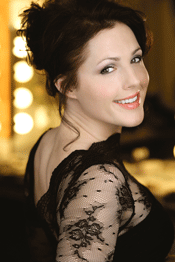 Leah Partridge [Photo courtesy Kristin Hoebermann]
Leah Partridge [Photo courtesy Kristin Hoebermann]
Roxane is interesting to DiChiera because “she evolves; her music evolves too. She goes from a dame precieuse to a mature person. Not everyone matures.” In 17th century France, groups of educated and articulate high society women gathered in the salon Chambre bleue for what developed into discourses on love (the derivation of the romance novel?) and a training ground for verbal thrusts and parries. These women came to be known les precieuse, not a moniker meant to flatter.
Here again, DiChiera finds another scenario many can relate to through the young Roxane: beauty, and even formally acquired intelligence, does not turn out inner beauty. That is a whole other set of qualities. It would seem that most everyone is familiar with the properties of “temporary beauty” (thank you Graham Parker). We are introduced to this Roxane, the dame precieuse, early in the story. She is preoccupied with physical appearance. Soprano Leah Hunt Partridge, DiChiera’s first Roxane, calls her “a dreamer, an idealist.” Her transformation begins to take critical shape when she digs deep into what she thinks are letters written by Christian.
 Sebastien Gueze [Photo by Lucile Leber]
Sebastien Gueze [Photo by Lucile Leber]
Roxane comes into her own when her heart feels “these letters, the emotion of the letters,” DiChiera wrenches. Her worldview crystallizes as she comes to terms with what has happened — the writing is searching for, and intimate to, her; this can only be love. The author of these letters wrote with a profound personal love for Roxane. Towards the end, she recognizes Cyrano’s voice in the writing. It is he that feels these words, yet he was willing to sacrifice himself (protecting Christian as Roxane asked and speaking for her young suitor in the letters) for her sake; this is love.
DiChiera speaks of Christian as if he were a darling son, je jeune but wholly honorable. “In Christian’s aria, he is monologuing with himself. He reaches a point when he realizes he has to let her [Roxane] go.” At this point, Roxane has told Christian how she feels about the letters. Christian, in his inner wrestling, feels how moved Roxane is; crestfallen though he is, Christian understands what must be done. Rostand’s story makes it possible for “people to take, and identify with, things differently,” as DiChiera states. “For me, Christian is not stupid like we like to say, he is just losing his words in front of her, the idea was from Cyrano,” this from Sebastian Gueze, performing Christian and for the first time with FGO.
Music, and opera particularly, can facilitate the empathy and varying interpretations DiChiera and Gueze speak of: “Listen to how the music goes inside. I’m an opera-lover. Music can express what words cannot express.” At best, where a segment of a story is better served by reconfiguring it through one of music’s conventions, poetry and music melt into one, an “operatic” moment. The ensemble is such a convention.
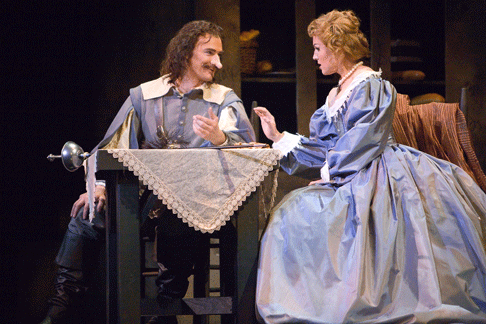 Les cousin: Cyrano (Marian Pop) and Roxane (Leah Partrigde) [Photo by John Grigaitis]
Les cousin: Cyrano (Marian Pop) and Roxane (Leah Partrigde) [Photo by John Grigaitis]
In Act II of Rostand’s play, a host of characters intersect back and forth before the wedding ceremony — each plays an important role with an equally important message to relay. Such a scene may not translate well operatically; there are issues of time and character development to take into account. “I added the idea of the quintet. That is what opera can do,” DiChiera says matter-of-factly about a construction that can be musically and textually (involving Uzan) complicated. The moment in the opera is basically the same. The set of characters meet in a balcony, their comments are similar; the music takes loosely related text, and fuses and condenses the whole into one number.
The primary cast for Cyrano is rounded out with Le Bret and Count de Guiche. In Le Bret, Cyrano has a confidant and admirer who tells it like it is. The Le Bret in this production, baritone Aaron St. Clair Nicholson, says this of Le Bret, “His strengths are in his loyalty and determination.” “Cyrano does not achieve his full potential but dies only after confiding what Le Bret encouraged him to years before.” The wealthy and influential Count de Guiche is the story’s foil: he wants to possess Roxane as she finds ways to ward him off. Bass Peter Volpe, making his FGO debut as the Count finds an interesting character triangulation, “the specific difference between him, Cyrano and Christian for me is, de Guiche simply lusts after her and the other two are genuinely in love.”
There is another, symbolic element to Cyrano that relates to how our souls are touched by shared humanity, things that reside within us all. It is present in the juxtaposition of Cyrano and Christian as alter egos. Gueze captures this eloquently, “the audience understands before the protagonists that one of them must disappear and die for the other one!” Even though we know how the story ends, this is what has us return to Cyrano time and again in whatever form is conceived to tell his story. The Cyrano in all of us is invited to rise and, if only for a moment, we find ourselves in him. All characters are welcome.
Robert Carreras
image=http://www.operatoday.com/DiChiera.gif image_description=David DiChiera [Photo by Ameen Howrani courtesy of Florida Grand Opera] product=yes product_title=David DiChiera: Cyrano product_by=Cyrano: Marian Pop; Roxane: Leah Partridge; Christian: Sébastien Guèze; De Guiche: Peter Volpe; Le Bret: Aaron St. Clair Nicholson; La Duègne: Courtney McKeown. Conductor: Mark Flint. Stage Director: Bernard Uzan. Set and Costume Designer: John Pascoe. Lighting Designer: Donald Edmund Thomas. product_id=Above: David DiChiera [Photo by Ameen Howrani courtesy of Florida Grand Opera]A Dinner Engagement
The sixteen-year-old company that exclusively showcases local talent staged British 20th century composer Lennox Berkeley’s one act comic opera A Dinner Engagement to the delight of an appreciative audience.
The story centres around an English family, Lord and Lady Dunmow, played by baritone Michael Dunbar and soprano Margot Harding, who have fallen on hard financial times in the 1920s. They have their sights set on marrying off their daughter Susan (wonderful young soprano Deanna Smith) to HRH Prince Phillipe (tenor Michael Au) who is coming to dinner with his mother, the Grand Duchess of Monteblanco, portrayed by mezzo soprano Elizabeth Rotoff.
We first meet Lord Dunmow in the kitchen, an authentically detailed set with everything from a cast iron stove to jars of preserved fruit. The bumbling Dunmow endeavours to follow a recipe in preparation for his dinner guests. Reminiscing about better times, his full-bodied baritone voice is wistfully expressive in the bittersweet “In the Summer of my Time.” On a few occasions, however, his voice seemed to fail him, due to support issues. And despite his culinary ineptness, one still wishes he would pronounce the herb ‘rosemary,’ instead of ‘Rose Marie,’ like the 60s comedienne.
Harding, as his wife, has the ability to light up a stage whenever she appears. Commanding and stylish, she has a reliable and powerful voice, with a fresh, rich tone. And with her impressive acting ability, Harding is the full package.
Veteran mezzo Linda de Pauw played Mrs. Kneebone, the kitchen help, with true comic flair. Her diction was clear and precise, although the Cockney accent drifted in and out.
The Dunmows and Kneebone were hilarious in “Prenex six Belles Tomates,” cooking up a storm, chopping vegetables crazily as stems and bits flew around the room.
Smith was a breath of fresh air as Susan, her pretty, refined voice seeming to float to the highest notes without a trace of effort. With a pure, crystal clear tone and delicate lightness to her voice she was the highlight of the production.
Enter Rotoff, brilliantly haughty and convincingly statuesque as the Duchess, and Au, as Phillipe, dressed in a dapper suit. Au has a solid, powerful voice, but he struggled with some of the difficult intervals in “Mon aimée attend la lune,” going out of tune and sounding constricted in his upper register. He also tended to employ the princely accent inconsistently. His acting, on the other hand, was well suited to this comic style, as he gazed dreamily at Susan with puppy dog eyes.
Tenor Darryl Brunger had a small role as the delivery man, appearing twice demanding money. His first effort was secure, with pleasing tone quality, but when he returned the second time, his intonation faltered.
Michael McKay did a fine job accompanying the entire show on piano and creative lighting eliminated the need for scene changes. Flowers projected on the backdrop while lowering the lighting on the overall set effectively moved us into the garden. Very smart!
Berkeley’s score doesn’t offer us much in the way of tunefulness, and all dialogue (lyrics by Paul Dehn) is sung, requiring much abandonment of disbelief from the audience.
But this was obviously a labour of love for all involved and the result was a nice little (one-hour) opera confection that brightened a rainy evening.
Gwenda Nemerofsky
image=http://www.operatoday.com/Lennox_Berkeley.gif image_description= Lennox Berkeley [Photo © Colin Busby courtesy of G. Schirmer] product=yes product_title=Lennox Berkeley: A Dinner Engagement, Op. 45 (1954) product_by=Little Opera Company (Winnipeg), Salle Martial Caron, April 8 & 9,2011 product_id=Above: Lennox Berkeley [Photo © Colin Busby courtesy of G. Schirmer]April 19, 2011
Handel’s Hercules when the Music is Paramount
Further, the setting, costumes, and gestures suggest, alternately, the concept of the hero returning from military successes and the accompanying domestic reconciliations which must also be confronted. The specific associations with modern political and military conflicts, under Peter Sellars’ direction, are, to be sure, communicated in such a way that more elemental affects predominate. Hence although some costuming is admittedly tied to recent struggles in Iraq, the resultant application speaks for universal emotions beyond any single war. This dramatic success may be ascribed in part, to the musical direction but at the same time to the extraordinary collection of vocal talent assembled for this production.
In his attempt to shape “the piece with a view to bringing Händel’s oratorio closer to Sophocles original play,” Mr. Sellars divides the work into two parts rather than three acts. The sets remain generally simple, several benches affording the performers opportunity to sit or lie while broken columns suggest a neglected domestic court. In the overture to the first part Harry Bicket led with agile tempos and managed the integration of individual orchestral sections into a seamless whole. As the first participants to appear in the initial part David Daniels as the herald Lichas and Alice Coote as Dejanira, the wife of Hercules, inhabit their roles with conviction and dignity. Dejanira enters as the colors on the backdrop of the stage change to indicate day’s arrival. She seems weary and hugs herself as if to ward off the cold, or solitude. In his comment on observing the state of Dejanira Mr. Daniels performs the first of Lichas’s solo pieces with skilled and tasteful decoration. His emphasis on “relentless” in the aria “No longer, Fate” communicates the mood of the court as mirrored in Dejanira’s gestures. Further, in his plea to Jove, Daniels uses discreet trills alternately on “the hero’s life” and “weeping wife” as a means to join or contrast the two figures musically who are kept physically apart by war. In her own self-distracted and pessimistic musing in the aria “The world, when day’s career is run,” Coote gives appropriately expressive color to low notes on “darkness” and “thickest gloom.” She sings her final lines here, in echo of the sentiment of Lichas, with decorative and emphatic trills on “absence” as key to her emotional anguish.
In the following several scenes the fate of Hercules is presented, alternately, in negative and in optimistic lights, as the remaining characters of the piece are introduced. At first, Hyllus, son of Hercules and Dejanira, vows to search for his father after he consulted an oracle that predicted death for the hero. In order to assuage his mother’s mood at this news, Hyllus swears his conviction in the recitative and heroic aria, “Despair not … Where congealed the northern streams.” In the role of Hyllus Richard Croft gave a supremely assured performance of the loyal son and future leader. His vocal embellishments, presented in the most natural manner, describe “With advent’rous steps” the path he will tread until discovering the fate of his father. As accompanied by the chorus’s thoughtfully choreographed “O filial piety,” Hyllus is on the point of leaving when Lichas interrupts with news of his master’s success. Hercules has defeated the king of Oechalia and returns with the princess as his captive. In Dejanira’s reaction, “Begone, my fears,” Ms. Coote applies excited touches of decoration on “the morning ray” and concludes with a dramatic top note at the phrase “swell my soul” to signal her recovery.
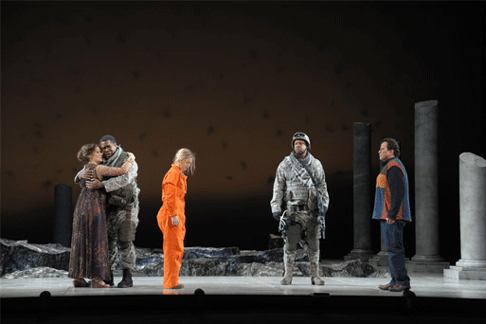 (Left to right) Alice Coote, Eric Owens, Lucy Crowe, Marckarthur Johnson and Richard Croft
(Left to right) Alice Coote, Eric Owens, Lucy Crowe, Marckarthur Johnson and Richard Croft
In the following scene the characters Hercules and Iole, the captive princess, enter and establish their dramatic and vocal personalities. The two initial arias performed by Lucy Crowe as Iole were exemplars of character portrayal and Handelian decoration. While Hyllus looked on with growing interest Ms. Crowe performed “Daughter of Gods” with a seamless line and flute-like, rapid high notes on “a thousand graces.” Her saddened memories in “My father! Ah! Methinks I see” were equally expressive with noted ornaments touchingly applied on “Dying he bites the crimson ground.” The role of Hercules, sung by Eric Owens, remains at this narrative juncture implicitly understated. Mr. Owens communicates the introspection and detachment of the hero returned in “The god of battle quits the bloody field,” while also tracing a lyrically embellished line for the bass-baritone. From this point until the close of the first part the growing rift between Hercules and Dejanira is detailed in the latter’s reaction to Iole’s presence. As if to highlight her innocence, the aria “How blest the maid” is performed by Ms. Crowe with near pastoral effect as she uses delicate high notes with crystalline effect. By contrast, Dejanira’s anger and jealousy are expressed by Ms. Coote’s negative emphases in “Love dips his arrows … and sends them pointed to the heart.” The emotional violence implied, as well as her own reactions, is captured by Coote’s contrastive embellishments opposing her role to that of Iole. As the chorus appropriately concludes the first part of the drama, the participants remind with hushed tones that “Jealousy” is “Tyrant of the human heart.”
Just as Hercules and Dejanira stand in this production at the close of Part I at opposite sides of the stage, in order to signify their continued emotional distance, Hyllus and Iole appear together at the start of Part II. In answer to Iole’s protests that love between them cannot prosper, since Hercules slew her father, Mr. Croft expresses the growing passion of Hyllus with eloquent lyricism. His downward decorations on the first line of the aria “From celestial sets descending” are matched by embellishments in the thematic line “To taste the sweeter heav’n of love.” The following scenes signal a further separation between Hercules and Dejanira, as Coote mocks him with growing intensity in the aria “Resign thy club and lion’s spoils.” As Hercules departs for a ceremony of honors Dejanira recalls a method in her possession to restore a flagging love. The dying centaur Nessus had convinced her that his blood would revivify love gone astray. Not realizing that it is poisonous, she smears it onto a garment which she entrusts to the herald Lichas to bring as a gift to Hercules. The horrified report of Lichas ensues, in which the suffering and death of Hercules resulting from the poisoned garment is related. The hero is depicted lying on a stone slab from which Mr. Owens sings the aria “I rage” with rapid and expressive runs in the vocal line. The following two scenes bring to a dramatic and lyrical climax the sentiments defining both lead female characters. Dejanira is beset by guilt which Coote declaims with moving fervor in “Where shall I fly?” Her embellishments on the “skies” as witness to her guilt conclude with memorable dramatic high notes on “the pursuing furies of the mind.” Iole’s aria in response, “My breast with tender pity swells,” reiterates the tone of reconciliation which characterized her role in this foreign household from the start. Ms. Crowe’s simple yet decorative trills on “breast” and “pity” served as a means to deflect the harsh feelings of enmity and guilt which had preceded the demise of the hero. The final duet of love “O prince … O princess,” sung by Iole and Hyllus, brings now full circle the constellation of emotions as survivors and chorus pass the bier of honor with Hercules’s remains.
Salvatore Calomino
image=http://www.operatoday.com/Hercules_Chicago_01.gif image_description=Alice Coote as Dejanira and David Daniels as Lichas [Photo by Dan Rest courtesy of Chicago Lyric Opera] product=yes product_title= product_by=Dejanira: Alice Coote; Hercules: Eric Owens; Lichas: David Daniels; Iole: Lucy Crowe; Hyllus: Richard Croft. Conductor: Harry Bicket. Director: Peter Sellars. Set Designer: George Tsypin. Costume Designer: Dunya Ramicova. Lighting Designer: James F. Ingalls. Chorus Master: Donald Nally. product_id=Above: Alice Coote as Dejanira and David Daniels as Lichas [Photos by Dan Rest courtesy of Chicago Lyric Opera]Americans define new territory for songs
(When did you, for example, last hear Elie Siegmeister’s Strange Funeral in Braddock, the 1936 documentation of a day when Marxism was not yet a curse in America?) Happily, things are changing — largely due to the commitment to song on the part of two Americans now moving toward middle age: Jake Heggie and Ricky Ian Gordon.
True, both men made their strongest mark in opera. Heggie’s Dead Man Walking, premiered in San Francisco in 2000, has become the most-performed opera of the 20th century, although in all probability it will soon by outranked by his Moby Dick, first staged by Dallas Opera a year ago. And Minnesota Opera offered Gordon’s touching treatment of Grapes of Wrath in 2007. Although both men are somewhat too easily pegged as “post-Broadway” and “post-Sondheim,” their achievement of the past month indicates it is time to take them with greater seriousness and see them as original and unique voices that elevate the status of American music. Their newest achievements in songs define new parameters for the genre.
*******
Heggie returned to Dallas’ Winspear Opera House on April 8, 2011,for the premiere of a new song cycle, A Question of Light. The six songs, again a colaboration with Gene Scheer, whose poems respond to works in the Dallas Art Museum, celebrate the philanthropy of Margaret McDermott, for whom the Winspear’s auditorium is named. “They are works either given to the Museum by Margaret or by friends in tribute to her,” explained Scheer, whose partnership with Heggie finds the two widely referred to as the “Strauss/Hofmannstal of the 21st century.”
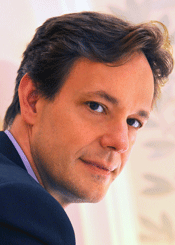 Jake Heggie [Photo © Ellen Appel]
Jake Heggie [Photo © Ellen Appel]
“We had turned earlier to works of art for inspiration,” Scheer added “And in Dallas we had gotten to know Margaret, an incredible philanthropist and a great friend.” Scheer and Heggie toured the Dallas Museum to study 40 works that fit the definition of the project. “There were six that immediately triggered my imagination,” Scheer said. “I found words right away for Magritte, but came up with nothing for Mondrian — and then one day it was there.”
The works are: The Light of Coincidences by Rene’ Magritte, a Mayan flint depicting a crocodile canoe from between 600 and 900A.D., Gustave Caillebotte’s Yellow Roses in a Vase, Piet Mondrian’s Place de la Concorde, El Hombre by Rufino Tamayo and Gerald Murphy’s Watch. “Jake had his heart set on the Tamayo,” Scheer said. “And I loved it as well.”
Although Scheer’s poems stand stably on their own (the audience would have gained from projection of the texts), they are enhanced by the changing moods of Heggie’s candidly romantic settings. Heggie sets the cycle in motion with bell-like Impressionist sounds for Magritte, grows dreamy in Caillebotte and gains Latin force in flavor in Tamayo. Heggie, long the master accompanist of his work, partnered baritone Nathan Gunn in the premiere. While Gunn sings Mozart’s Papageno at the cavernous Met, the 2,200 Winspear seemed a trifle large for his cultivated delivery.
On the second half of the program, a gala fundraiser for Dallas Opera, Gunn turned to music reaching from Home on the Range to a “hit” from Camelot. Here he was almost upstaged by his keyboard partner — and also his wife — Julie Jordan Gunn, a professor of music at the University of Illinois at Urbana-Champaign. “Moby Dick took me to a new level in my composition,” Heggie said. “And these songs are a direct extension of that musical language and world. “Each part of the cycle asks who we are and how we fit into the landscape — what a work of art says to us, and what we bring to it as we look at it as well.”
*******
It was hardly a coincidence that the Virginia Arts Festival scheduled the world premiere of Rappahannock County for April 12, 2011. For it was on April 12, 1861 that the attack on Fort Sumter in Charleston Harbor launched the Civil War. Rappahannock County, a music theater piece composed by Ricky Ian Gordon with texts by Mark Campbell not only recalls that event, it traces the fate of the divided nation through the five years of war that followed. To add to the significance of this cycle of 22 songs that follow the feelings of those affected by the war the Festival made the premiere the opening event of its 15th anniversary season.
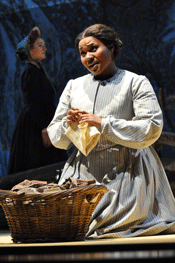 Aundi Marie Moore and Faith Sherman [Photo by David Beloff courtesy of Virgina Arts Festival]
Aundi Marie Moore and Faith Sherman [Photo by David Beloff courtesy of Virgina Arts Festival]
In commissioning it, Virginia Festival director Robert Cross asked only for a work on the Civil War. What exactly it would be was up to Gordon and Campbell. “I couldn’t see a big three-act opera on the war,” Gordon says. “The challenge was to make the subject manageable — to cut it down.” Gordon brought Campbell on board, and they both started reading.
“Virginia was so central to the war — and so divided!” Gordon says. “We decided to focus on just one county in the state: Rappahannock.” The two decided on music theater as their genre, and Gordon thought in terms of a cycle of songs to be performed by a small group of singers, each of whom plays a number of roles. Although the final score is divided into five acts — one for each year of the war — they are performed without interruption. The work lasts 85 minutes. “The poems offer no cohesive narrative, they must be performed without intermission,” the composer says. “That would break the mounting intensity of the cycle.”
Campbell’s texts draw on letters, diaries and other documents from a group of people, both black and white, who experienced the impact of war first hand. The goal of the creative team was a work in which individuals speak with intimacy. “But the personal is political,” Gordon says, “and the political is personal. “The piece has the sense of a lens closing in on a spectrum of individuals and their feelings around slavery and morality in a profound and poignant way. Mark’s libretto shows what everyone has to lose — or has lost.”
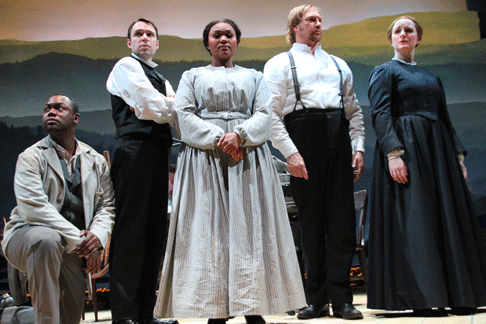 Full cast of Rappahannock County [Photo by Rachel Greenberg courtesy of Virginia Arts Festival]
Full cast of Rappahannock County [Photo by Rachel Greenberg courtesy of Virginia Arts Festival]
The acclaim accorded Rappahannock County by the 2,200 people who packed Norfolk’s Harrison Opera House for the premiere made clear that Gordon and Campbell had achieved their goal. The work, described by Gordon as “a series of snapshots of life and loss during the war,” makes no attempt at narrative unity, but focuses rather on intensely emotional moments in the lives of 30 individuals portrayed in Norfolk by five extremely talented young singers. Indeed, soprano Aundi Marie Moore, mezzo Faith Sherman, tenor Matthew Tuell and baritones Kevin Moreno and Mark Walters were an unusually well balanced group of singers who clearly had taken the message of this stellar new work to heart. For the texts Campbell created a language magnificently suited to their contents. It reflects the period and the events described with no attempt at dialect-like coloring. Wisely, the texts were projected as supertitles during the performance.
The 17-pieces orchestra — Rob Fisher conducted Bruce Couglin’s orchestration of the score — played behind a scrim, on which were projected telling visuals designed by Wendall Harrington. They included actual photographs along with landscapes and documents that contributed much to the easy flow of the score. Gordon had wanted the songs to be performed without interruption; but, growing applause documented the increasing involvement of the audience during the premiere performance.
Costumes were by Jessica Jahn; lighting by Robert Wierzel. Kevin Newbury directed the production.
Rappahannock County is a co-commission of the 2011 Virginia Arts Festival, Virginia Opera, the University of Richmond and the University of Texas in Austin, The Norfolk production will be staged at both universities in September 2011.
*******
Next up for Jake Heggie and Gene Scheer is a commission from Houston Grand Opera for a set of songs marking the 10th anniversary of the 2001 terrorist attack on New York City. “Through music, the work will honor Houstonians affected by the attack,” said HGO general director Anthony Freud in announcing the commission. “Music, after all, has the ability to tell a story and enable people to reflect and connect with each other.”
Scheer is developing texts from — among other sources — interviews with Houston firefighters who went to New York to assist in rescue operations and from telephone messages left by a Houston-born woman on the flight that went down in Pennsylvania. Freud has asked Heggie for a “transportable” work, written for example, voice plus guitar, violins or flutes. “This will make it possible to perform it in many different venues from fire stations, city-hall foyers and hospitals,” Freud said. Plans are not yet definite. Yet, the HGO hopes to premiere the work in Houston’s Rothko Chapel. This is the eighth Heggie-Scheer collaboration.
Wes Blomster
image=http://www.operatoday.com/Rappahannock-County---Kevin.gif image_description=Kevin Moreno [Photo by David Moreno courtesy of Virginia Arts Festival] product=yes product_title=A Question of Light, a song cycle by Jake Heggie and Gene Scheer. Winspear Opera House, Dallas, April 8, 2011Rappahannock County, a musical theater piece by Ricky Ian Gordon and Mark Campbell. Harrison Opera House, Norfolk, Virginia Arts Festival, April 12, 2011 product_id=Above: Kevin Moreno [Photo by David Moreno courtesy of Virginia Arts Festival]
Ian Bostridge, Wigmore Hall
In previous incarnations, Bostridge’s Romantic wanderer has been a woeful, weary figure, made wretched and emotionally drained by life’s cares and the loss of love. Here, guided by Uchida’s rhythmically charged, honest utterances, he was an altogether more self-determining journeyer, at times despairing, elsewhere angry, but even in moments of confusion and anxiety, always self-aware and self-possessed.
The rhythmic momentum of the strumming chords which open ‘Gute Nacht’ (‘Good night’) drew us immediately into a narrative which seemed to have begun long before, and a bitter energy underpinned the icy clarity of ‘Gefrorne Tränen’ (‘Frozen Tears’) and ‘Erstarrung’ (‘Numbness’). But, in the central poems, as the dark currents which well up from the traveller’s desperate wandering and his own tortured imagination plague and afflict him, a new reticence was sensed, apt for the beleaguered mood. The pensive restraint of ‘Irrlicht’ (‘Will-o’-the-wisp’) and ‘Frühlingstraum’ (‘Dreams of spring’) intimated that the wanderer had succumbed to reverie and fantasy, but this was challenged at times by a growing acknowledgement of his own delusion, in ‘Einsamkeit’ (‘Loneliness’) and ‘Der greise Kopf’ (‘The hoary head’). In the latter half of the cycle, the performers exploited Schubert’s sparser textures and greater economy of means (together with fewer textual repetitions) to develop a powerful concentration and angry passion as the wanderer is brought by his own inner thoughts to the brink of suicide.
Contrast and clarity were the touchstones of this interpretation; in this regard, Uchida painted the canvas, and determined the colour palette, upon which Bostridge spun the tale. Juxtapositions of major and minor were tellingly shaped. The piano accompaniment welled from subdued pianissimos to assertive pronouncements, sensitive to the singer’s need to project the text but always an active player in the musical and narrative argument. The reticent opening of ‘Wasserflut’ (‘Flood’) gave way to the strong, assertive bass line accelerating at the conclusion of ‘Auf dem Flusse’ (‘On the river’), symbolic of the ‘raging torrent’ beneath the surface. Discarding the pedal in ‘Rast’ (‘Rest’) Uchida’s sparse, raw accompaniment served to intensify the singer’s final outburst — ‘You too, my heart, … you feel stirring in this stillness/ the fierce pangs of anguish!’; and the delicate ornamentation of the following song, ‘Frühlingstraum’, remained tempered by the dry coldness of the preceding song, climaxing in a subdued ardency, the modulation to the minor tonality denying hope of resolution to the singer’s urgent question: ‘When shall I hold my love in my arms?’
Bostridge too made much of every opportunity for contrasting timbres and hues, intensifying the aching yearning in ‘Wasserflut’ to convey the young man’s ‘burning anguish’, before adopting a wonderfully soft piano as the ‘ice breaks into fragments/ and the soft snow melts’. Creating a magical veiled quality in ‘Einsamkeit’, he relished the chromatic anguish of the wanderer’s struggle, ‘I go on my may/ with dragging steps.’ Here, Uchida retreated to allow the text to come through in all its abject honesty: ‘While storms were still raging/ I was not so wretched.’
Each song had its striking, and sometimes surprising, features. The staccato punctuations of ‘Gefrorne Tränen’ seemed to undermine the wanderer’s hope that, springing from his heart with such fierce heat, they ‘would melt/ all the winter’s ice’; and this was further confirmed by the despairing diminuendo at the conclusion of the subsequent ‘Erstarrung’: ‘My heart seems dead, her cold image numb within.’
In Müller’s poems, natural symbols and natural events are used to explore man’s relationship with Nature, and thus such symbols are both literal and metaphorical. Uchida powerfully conveyed this simultaneity in ‘Der Lindenbaum’ (‘The linden tree’). Having adopted a fairly slow tempo for this song, the piano’s sudden blast of ‘cold winds … full into my face’, which dislodge the wanderer’s hat and disturb his illusory peace, was powerfully evocative. Similarly, Bostridge demonstrated a startlingly affecting lower register in ‘Der greise kopf’, suggesting the distant depths of the silent grave to which the wanderer travels.
A troubled urgency marked the concluding songs, initiated by the staccato accompaniment of ‘Letzte Hoffnung’ (‘Last Hope’) and propelled by the tempestuous diminished triads shared by voice and piano in ‘Der stürmische Morgen’ (‘The stormy morning’). The barking dogs and rattling chains took on a distinctly sinister air in ‘Im Dorfe’ (‘In the village’), as the performers exploited every emotional resonance in Schubert’s contrasts of major/minor tonality and register.
A burnished gravity characterised ‘Der Wegweiser’ (‘The signpost’); well-placed ornaments and sprightly dotted rhythms in the piano were undermined by the hushed vocal timbre and final acknowledgement that there is but one road that must be travelled: ‘from which no man has ever returned’. Bostridge’s bitter resignation was overwhelmingly powerful here, yet he resisted the temptations of emotional excess, maintaining a restrained, eerie quality in ‘Das Wirthaus’ (‘The inn’), for his avowals, ‘I am weary, ready to sink,/ wounded unto death’. Uchida, however, was unwilling to allow passive surrender and the piano postlude injected a fresh resolution and brightness, leading into the forced bravado of an impetuous ‘Mut!’ (‘Courage!’). The contrast of melodic confinement and harmonic yearning in ‘Die Nebensonnen’ reached a touching conclusion in the repeated interrupted cadences which convey the wanderer’s melancholy admission of defeat: aware that the ‘best two’ suns are now lost, he still longs, ‘If only the third would follow’. Yet, the performers continued to interrogate and explore the music and text, and a startling icy anger pervaded the doom-laden final song, ‘Der Leiermann’ (‘The organ-grinder’).
In a letter of 1822, Müller wrote: “My songs lead but half a life, a paper life of black and white … until music breathes life into them, or at least calls it forth and awakens it if it is already dormant in them.”* Bostridge and Uchida certainly awakened the ‘dormant’ music in these texts. Never overly complex or angst-ridden, never compromising the simplicity and directness of verse — its ‘black-and-white-ness’ — they depicted the bleak journey of an outcast wanderer with poignancy but without sentimentality. A moving and enlightening performance.
Claire Seymour
*G. Johnson (1997), CD booklet for The Hyperion Schubert Edition, vol.30: Winterreise (Hyperion CDJ33030), p.4.
image=http://www.operatoday.com/bostridge-portrait.gif image_description=Ian Bostridge product=yes product_title=Franz Schubert: Winterreise product_by=Ian Bostridge, tenor; Mitsuko Uchida. piano. Wigmore Hall, London, Thursday, 14 April 2011. product_id=Above: Ian BostridgeAkhmatova in Paris
At least it seemed so, judging by the empty seats of the sixth and final performance of Bruno Mantovani’s Akhmatova at the Bastille (and the even more empty seats after intermission).
Just when Parisians have breathed a collective sigh of relief that the Gerard Mortier reign of terror has ended. [Gerard Mortier is a notorious impresario now in Madrid.]
This French Mantovani (only the name is Italian, with no relation to Annuncio Paolo Mantovani) is 37 years old. His musical idiom is a continuum of sonic explosions effected in astringently classical mediums. For Akhmatova he used a Beethoven orchestra with a couple of clarinets added plus some extra brass and a remarkably restrained percussion battery. In a concert the previous evening of piano music by Mr. Mantovani only the piano keys were struck, there was no amplification or other extra-classical application. His string quartets are just that.
There was a time when an opera was credited to the author of its play, its composer only identified on a second line. Turning back to this custom of bygone centuries let us credit this work, Akhmatova, to its creator, one Christophe Ghristi, dramaturg of the Toulouse Opera who presented the idea and libretto to Bruno Mantovani. It is a book of complex theme and sad to say little poetry.
Strange to say little poetry because Anna Akhmatova, if you did not know, is one of Russia’s great poets. Like many of the important Soviet era artists she was tortured by her art and tortured by her social responsibility. Ghristi exposes Akhmatova’s tortures not through her poetry, but by recounting a back story — her alienation from her son Lev, alienation that was both artistically and politically motivated. In fact her most beautiful poetry dwells on separation, but Akhmatova knows too that her art is superfluous. Thus by conscience she must condemn her son’s defense of the art of his father, the poet Nikolai Gumilyov who was executed by the Revolution.
So we have some pretty big themes put on the table. Too bad that they are left there. The story is told but rarely felt even though Mantovani’s orchestra is as sentient as Strauss’ orchestra, maybe even moreso. The Mantovani sonic vocabulary is enormous, based on repeated notes, trills, glissandi, and oblique tonal movement in, strange to say, almost Beethovenesque sonority. It is music that is potentially responsive to the biggest and smallest movements of the human spirit.
Note that there are no steps in a progression of tones, the term melody is not relevant. Accords between tones are equally irrelevant, any occasional suspicion of harmony is diffused by quietly apparent foreign tones. Like Rameau who bragged that he could set newspaper copy to music, there is no doubt, evidenced by Akhmatova, that Mantovani could as well — interesting, vital and beautiful music.
Mantovani is a lyric composer who is motivated by word, image and idea, real or imagined, the stuff of poetry. The Ghristi book gave him copy that he colorfully illuminated, but Ghristi gave him no poetry, and surprisingly incorporated a most minimal amount of Akhmatova verse though her quite brilliant poetry was certainly there for the taking!
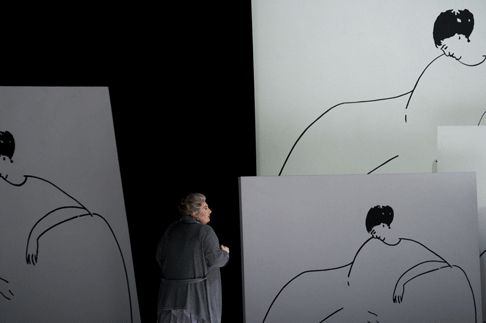
The Opéra de Paris production directed by Nicolas Joel and designed by Wolfgang Gussmann relied on the usual devices of slick modern storytelling. Its point of departure was the abstract portrait that Modigliani sketched of the 20 year old Akhmatova. This black and white image was omnipresent at the Bastille, and dictated that all color in the production would be within the gray scale (a brief bright red scene in the second act indicated a bit of frivolity). The Modigliani minimalism in fact informed all decor. It is a simplified staging idiom that seemed ignorant of or impervious to the luxuriant compositional techniques of Mantovani.
German mezzo-soprano Janina Baechle was Anna Akhmatova. Mme. Baechle’s usual repertory is Mistress Quickly, Brangene, Fricka, etc. The beautiful, young Akhmatova of the Modigliani sketch bore no relationship to the heavy-set, bitter, aged Akhmatova we saw all evening and who only made sense in the opera’s third and final act. The first and second acts lacked the presence of the thin, intense, charismatic Akhmatova of middle age who was illustrated by photographs in the program booklet. Such impersonation would have brought vibrancy and finally pathos to Mr. Ghristi’s story. As it was Mme. Baechle’s quite powerful performance was unfulfilling.
Romanian tenor Atilla Kiss-B. [sic] was Akhmatova’s son Lev. Mr. Kiss-B.’s usual repertoire seems to be emotionally complicated Strauss and Janacek roles, and that was his weight in this production. He is a striking performer who fully embodied the bitter, strident middle-aged Lev returned from the Gulag camps, but missed creating the naivete of Lev the idealistic university student in the early moments of the opera. His impressive delivery of his ugly adieu to his mother begged for the sense of the boy whose innocence was wasted.
The balance of a mismatched cast negotiated the Mantovani vocal lines with aplomb, no easy feat. Mr. Ghristi’s phrases were generally declaimed on a single note, jumping, seldom if ever stepping to subsequent tones to further the speech. From the initial downbeat conductor Pascal Rophé made Mantovani’s orchestra the center of attention. Perhaps there never was the possibility of the traditional operatic relationship between pit and stage as the Mantovani orchestral continuum naturally absorbs the voice rather than supports it.
Michael Milenski
image=http://www.operatoday.com/Akhamatova_01.gif
image_description=Janina Baechle as Anna Akhmatova and Atilla Kiss-B as Lev Goumilev [Photo by Elisa Haberer courtesy of Opèra National de Paris]
product=yes
product_title=Bruno Mantovani: Akhmatova
product_by=Janina Baechle: Anna Akhmatova; Atilla Kiss-B.: Lev Goumilev; Lionel Peintre: Nicolaï Pounin; Varduhi Abrahamyan: Lydia Tchoukovskaya; Valérie Condoluci: Faina Ranevskaya; Christophe Dumaux: the representative of the Writers' Union; Fabrice Dalis: a sculptor: an English Academic; Ugo Rabec: an agent. Pascal Rophé, conductor; Nicolas Joel, stage director; Wolfgang Gussmann, sets and costumes; Hans Toelstede, lighting. Paris Opera Orchestra and Chorus.
product_id=Above: Janina Baechle as Anna Akhmatova and Atilla Kiss-B as Lev Goumilev [Photos by Elisa Haberer courtesy of Opèra National de Paris]
April 18, 2011
Wuthering Heights, Minnesota Opera
By George Loomis [Financial Times, 18 April 2011]
Like Sir Arthur Sullivan, who with his opera of serious presumption Ivanhoe sought out a higher aesthetic plane than operetta afforded, the great film composer Bernard Herrmann wrote Wuthering Heights.
The Tsar’s Bride, Royal Opera House
Audiences expecting Sheherezade will be in for a shock. The Tsar’s Bride is no fairy-tale fantasy. The first image you see is one of a crumpled, semi-naked figure tied to a chair. Grigory Gryaznoy (Johan Reuter), the oprichnik, here seen as a kind of Mafia boss, removes the victim’s hood, it shows he’s been tortured. They are both in a luxuriously appointed night club, after hours. Waiters mill about, but no-one dares intervene. It’s a metaphor for the whole opera, which deals with the vicious abuse of power. Everyone can be bought if the price is right, sings Lyubasha (Ekaterina Gubanova). She knows she’s doomed, since Gryaznoy has found another love. When he and his cronies throw a party, they’re entertained by lap dancers, desperate young women who sell themselves to survive.
Luxury, contrasted with degradation. Gryaznoy has been smitten by Marfa Vasilyevna, (Marina Poplavskaya) the daughter of Vasily Sobakin (Paata Burchuladze). The family is happy as all seems to be going well. They are merchants from Novgorod. They don’t normally move in dissolute Court circles, but Marfa is engaged to her childhood sweetheart Ivan Likov (Dmytro Popov), who has returned to her after years in the Tsar’s service. Burchuladze, Popov, Poplavskaya and Jurgita Adamonytė (Dunyasha) sing the beautiful Act II Quartet joyfully but it’s heartbreaking to know what lies ahead.
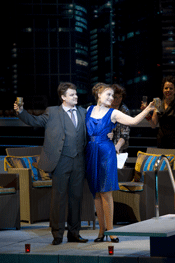 Dmytro Popov as Likov and Marina Poplavskaya as Marfa
Dmytro Popov as Likov and Marina Poplavskaya as Marfa
Rimsky-Korsakov writes relatively little for Marfa to sing until the end, because she’s a modest virgin. In Act II, Poplavskaya’s voice created Marfa’s optimism perfectly. She’s dressed at first in a version of a man’s three piece suit but that actually emphasizes her innate femininity. She’s not self conscious, she’s herself. No silly coquetry, but clear toned, directness of expression. Poplavskaya can be touchingly tender when she sings of her childhood, but she creates Marfa as a morally upright personality. It works well dramatically. because this honest Marfa has more integrity than anyone else. No wonder Gryzanoy and the Tsar are hypnotized. When a person like that gets destroyed by the mean and venal, it’s much more tragic than if it were someone you can’t relate to.
Act II takes place in an oligarch’s penthouse, complete with swimming pool and a breathtaking view of the Moscow skyline. New buildings, some still with cranes. New money, ostentatious consumption, greed. The Tsars weren’t the only rulers to misuse their authority, as Russian-speaking audiences were only too aware. Gryaznoy plots to win Marfa with a love potion concocted by Bomelius, the sinister German apothecary (Vasily Gorshkov) . What he doesn’t know is that Lyubasha has switched the potion for poison. What none of them know until the last moment is that the Tsar has pulled a switch on them all by deciding, arbitrarily, to marry Marfa himself. The Tsar (in this case Ivan the Terrible) is an invisible presence, all the more menacing because he’s unseen and unheard, but destroys everyone’s plans. Just as no-one stops Gryzanov, no-one stops the Tsar.
In the Tsar’s ornate, golden palace, Marfa, now Tsarina, is dying. Marina Poplavskaya’s portrayal of Marfa now revealed its true fire and intelligence. Poplavskaya is too good to indulge in standardized “mad scene”. She sings so each phrase means something, as if Marfa is trying to process in her mind a source of evil beyond her comprehension. “Where’s Likov?”, she’s thinking, and turns to Gryaznoy, mistaking him for the man she’s longing for. It’s so disturbing that even he is moved. Because Poplavska makes us realize that Marfa is a human being, not a lunatic, she makes us empathize.
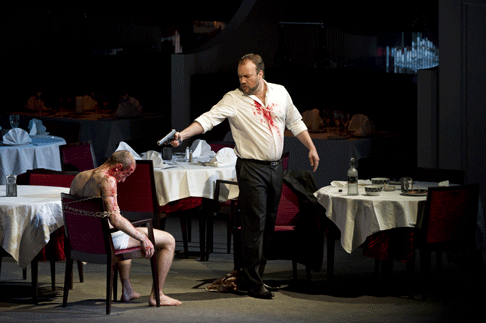 Johan Reuter as Gryaznoy
Johan Reuter as Gryaznoy
Poplavkaya’s Marfa is truly the daughter of a father like Paata Burchuladze’s Sobakin. As soon as he begins to sing in Act II, he lifts the ante for the whole cast. His is a real “Russian” bass, with dark gravitas, given extra colour by his extensive experience in Italian repertoire. His Act IV aria, “Zabylasya” compresses a huge emotional range into a few minutes. Sobakin isn’t a man of many words, but he’s deep. Even when he’s not singing, he’s a presence, blocked by the director Paul Curran so he’s the pivot of proceedings. Just as the Tsar doesn’t need to sing to be effective, Burchuladze stands at the centre of ensembles, observing and thinking. When he slits Gryaznoy’s throat, it happens so suddenly and subtly that you realize that Sobakin has been building up quietly to this final act of desperation.
Ekaterina Guberova’s Lyubasha was strongly characterized too. In Act I, she pleases the mobsters by singing her charming quasi-folk song, but adds a deliberate air of toughness, which shows how unnatural the situation really is. Perhaps Lyubasha was once like Marfa is now ? in the second Act, Lyubasha spies on Marfa and knows she can’t compete, Guberova captures her despair and revulsion at the price she must pay to bribe Bomelius. It’s only in her final aria that she confronts herself and Gryaznoy. “Straight through the heart” she sings when he stabs her.
Johan Reuter is a vocally acceptable Gryaznoy. But his even-toned solidity implies that he’s fundamentally too nice to portray a villain whose whole life has been spent casually killing and maiming. The part can be created with swaggering sexual menace, but not in this production. By falling for Marfa, Gryaznoy is beginning to see the error of his ways, but characters like that don’t normally reform or they don’t survive.
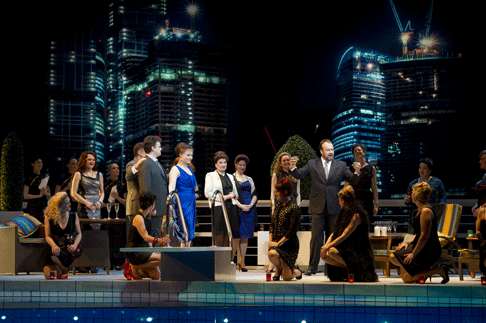 Act II (Left to Right) Jurgita Adamonytė as Dunyasha, Dmytro Popov as Likov, Marina Poplavskaya as Marfa, Anne-Marie Owens as Petrovna and Johan Reuter As Gryaznoy
Act II (Left to Right) Jurgita Adamonytė as Dunyasha, Dmytro Popov as Likov, Marina Poplavskaya as Marfa, Anne-Marie Owens as Petrovna and Johan Reuter As Gryaznoy
Alexander Vinogradov’s Malyuta-Skuratov is more in character, as was Vasily Gorshov’s Bomelius, but both have less to sing. Dmytro Popov’s Likov presented well vocally, but perhaps Rimsky-Korsakov realized that the role is no match against Gryaznoy or even, to some extent, to Marfa. Jurgita Adamonytė’s Dunyasha was well delivered but the role has “downcast eyes” as described in the text. Even Lyubasha dismisses her as a threat. As always, the chorus of the Royal Opera House was excellent, and the dancers were clearly professionally trained. No ordinary choristers can do high kicks and contortions like they did. In the pit, Sir Mark Elder conducted well, though not with the verve specialists in this repertoire might attain. Altogether,The Tsar’s Bride is a very good experience, which deserves to be heard again. Perhaps one day, when London gets the Russian idiom into its heart, The Tsar’s Bride will be appreciated for the opera it is.
The Tsar’s Bride runs from 14th April to 2nd May 2011. For more information please see the Royal Opera House website.
Anne Ozorio
image=http://www.operatoday.com/TSARS-BRIDE.201104081044A.gif
image_description=(Left to Right) Alexander Vinogradov as Malyuta-Skuratov, Ekaterina Gubanova as Lyubasha and Johan Reuter as Gryaznoy [Photo by Bill Cooper courtesy of The Royal Opera]
product=yes
product_title=Nicolai Rimsky-Korsakov: The Tsar’s Bride
product_by=Grigory Gryaznoy: Johan Reuter; Malyuta-Skuratov: Alexander Vinogradov; Bomelius: Vasily Gorshkov; Ivan Likov: Dmytro Popov; Lyubanova: Ekaterina Gubanova; Marfa Sobakina: Marina Poplavskaya; A young lad: Andrew O’Connor; Dunyasha: Jurgita Adamonytė; Petrovna: Anne-Marie Owens; Vasily Sobakin: Paata Burchuladze; Domna Ivankovna: Elisabeth Woollett; A girl: Louise Armit; The Tsar’s Stoker: Jonathan Coad. Orchestra and Chorus of the Royal Opera House, London. Conductor: Sir Mark Elder. Director: Paul Curran. Set: Kevin Knight. Lighting: Martin Jacques. Royal Opera House, London, 14th April 2011.
product_id=Above: (Left to Right) Alexander Vinogradov as Malyuta-Skuratov, Ekaterina Gubanova as Lyubasha and Johan Reuter as Gryaznoy
All photos by Bill Cooper courtesy of The Royal Opera
April 14, 2011
Muti, Standing Tall
By David Mermelstein [WSJ, 14 April 2011]
Even music lovers who do not regularly follow the health bulletins of their favorite artists must know of the conductor Riccardo Muti's travails in Chicago. They started earlier this season, shortly after Mr. Muti became music director of this city's venerable symphony orchestra, when he confronted the first of two medical situations that together forced the cancellation of many of his scheduled appearances.
Katarina Karnéus, Wigmore Hall
She’s given them in recital many times, but they’re so beautiful that it was a pleasure to hear her sing them again at the Wigmore Hall in London.
Obviously, live performances and recordings are completely different experiences. Recordings rarely recreate the immediacy of live performance. The Wigmore Hall is one of the finest recital halls in the world. Because it’s relatively small, it automatically creates ideal conditions for song and chamber music. The acoustic is famously warm and intimate. Indeed, the Wigmore Hall issues its own recordings, which can capture the distinctive atmosphere. Even the quietest sotto voce come over well. Sometimes this can be a disadvantage as every minor fault can be heard. But I don’t go to recitals for technical perfection, but to hear performers who care about what they are doing.
On this occasion, Karnéus wasn’t quite her usual self, especially in the first half of the programme where she sang adequately though her voice was dry and strained. Singers are human, and are their own instrument, so any trace of tiredness or ill health is amplified. Edvard Grieg’s Six Poems by Henrik Ibsen op 25 are so lovely that it didn’t matter that Karnéus wasn’t at her best. Her voice elided nicely in “En svane” which was significant, as this song has much in common, musically with Haugtussa (The Mountain Maid), op 67, which was to crown the second half of the recital.
Pianists, unlike singers, are not their own instrument. Julius Drake rose to the occasion. He played with even more grace and limpidity than usual. Every performance is different, and each has its own unique qualities. Here, Drake’s playing was so exquisite that it marked this recital as one in which you could luxuriate in the beauty of the pianism.
Sibelius’s Five Songs op 37, Drake’s playing demonstrated how important sensitive accompaniment is to song performance. The final chords of “Den första kyssen” seemed to echoing into the silence at the end of the song. An angel speaks to a maiden anticipating her first kiss, but hints that death might intervene before love. Often this detail is missed altogether, because it’s so subtle.
Karnéus was more assertive in Ture Rangström’s songs to words by Bo Bergman. She was particularly charming in Flickan under nymånen, where the young girl playfully thinks about her beau. Lilting, flirtatious rhythms, reminiscent of songs like “Killingdans” in Haugtussa. Karneus finished the song with a curtsey and a smile.
Perhaps Karnéus was shepherding her resources for Grieg’s masterpiece Haugtussa , because her voice opened out warmly. She was right to concentrate on songs like “En svane”, with similar challenges. Her voice sounded rejuvenated, soaring well on the climax “Å hildrande du”. Karnéus even looks like Veslemøy, “slight and dark and lithe, with a brown clear complexion and deep-set grey eyes”.
In Grieg, especially, the piano part is almost more crucial than voice, as it evokes mysteries that cannot be expressed in words. The vocal part is energetic and agile, but fundamentally innocent, at least in the first songs. Only when Veslemøy’s heart is broken, do her darker moods emerge. She has second sight, and is more attuned to nature spirits than to humans. Karnéus singing was clear and pure, but Drake’s playing was so exquisitely mercurial that he made the invisible presence of the spirit world feel palpable. He uses plenty of pedal, and echo. He captures the strange tonality in the music which hovers between keys and elusively changes tempo, often stopping suspended in mid-flow. It’s as if Grieg wants us to think of listening to the unheard and unseen.
For there are two parallel worlds in this cycle. One features Veslemøy’s life in the mountains and her unrequited love. The other represents the supernatural which haunts physical reality in Veslemøy’s clairvoyant imagination. Her music could almost be folk music, though it’s much more refined. The piano part, on the other hand, speaks of darker, more troubling forces. Sliding modulations, images of water in triplets that sparkle with light and life, yet also imply hidden depths and strange distortions. While Karnéus was fine, Drake was exceptional, and this performance was made me appreciate all the more the magic in Grieg’s music.
Anne Ozorio
image=http://www.operatoday.com/Katarina-Karneus.gif
image_description=Katarina Karnéus [Photo by Mats Backer courtesy of Good Company]
product=yes
product_title=Katarina Karnéus, Wigmore Hall
product_by=Katarina Karnéus, mezzo-soprano; Julius Drake, piano. Wigmore Hall, London
7th April 2011.
product_id=Above: Katarina Karnéus [Photo by Mats Backer courtesy of Good Company]
April 13, 2011
Dallas Boris a monument to Tarkovsky
The films — Solaris, allegedly a reaction to Kubrick’s 2001, and Stalker, a major meditation in science fiction — were the work of Andrei Tarkovsky, then widely celebrated as the greatest genius of Russian film since Eisenstein.
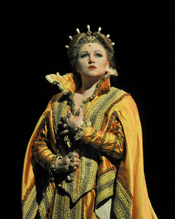 Elena Bocharova as Marina Mnishek
Elena Bocharova as Marina Mnishek
Today, alas, Tarkovsky seems largely forgotten despite a further pair of masterpieces made after his defection from the then-still Soviet Union: Nostalghia [sic], made in Italy in 1983, and Sacrifice, in Sweden, in 1986, the year of his death. (For the latter he had the help of several Ingmar Bergman regulars.)
It was also in 1983 that Tarkovsky directed Boris Godunov at Covent Garden, and Dallas Opera is to be praised — and thanked — for bringing this production to its Winspear Opera House to conclude its current season. Stephen Lawless, who recreated the London staging in Dallas, had been Tarkovsky’s assistant at Covent Garden. His essay in the Dallas program is a tribute — both fitting and moving — to this late master. (Tarkovsky, by the way, had been the choice of Claudio Abbado who conducted the British Boris.)
Lawless speaks of this Boris as the product of “a unique apostolic succession of Russian artists,” pointing out that while Tarkovsky was influenced by Eisenstein, Eisenstein, in turn, was inspired by the epic sweep of Boris. Mussorgsky, of course, turned for his libretto to Pushkin, the father of Russian literature who had defined the Russian language.
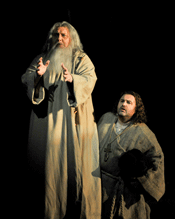 Vitaly Efanov as the monk/historian Pimen and Evgeny Akimov as Grigory
Vitaly Efanov as the monk/historian Pimen and Evgeny Akimov as Grigory
This revival of Tarkovsky’s Boris might well have run aground on so much scholarship, but — happily — it did not, thanks largely to Lawless’ understanding — and appreciation — of the heritage of which he became a part in his work with this production. For it, designer Nicholas Dvigubsky has built a single set focused on a huge arch at the rear of the stage. All action flows through it. Still a work in progress, it arises out of the debris of earlier projects.
In the Coronation Scene a bell is suspended from the arch; at other times a huge ball swings ominously behind it. The people, the helpless victims of history, reside largely in darkness before the arch. A profound expression of his views, the set magnificently complements the counterpoint of the personal and political at the heart of Tarkovsky’s concept.
Born in 1932, he experienced the worst of history: the terror and deprivation of the Stalin years, the sufferings of the Great Fatherland War — as the Russians called it — and the Orwellian machinations of the post-war era. (Small wonder that — once permitted to work in the West — the director chose not to return home, even though it meant separation from his only child for his remaining years.) His Boris is both a loving father and — no matter how he got there — a leader who would be just. But — as Bert Brecht said — “the conditions just aren’t right.” Surrounded by petty ambition on all sides, he can only fail.
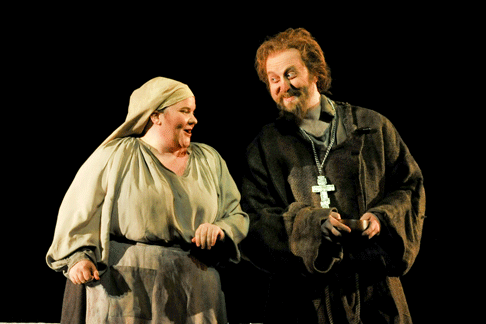 Meredith Arwady as the cheeky Hostess of the Inn shares a lighter moment with Mikhail Kolelishvili as Varlaam, a vagabond monk.
Meredith Arwady as the cheeky Hostess of the Inn shares a lighter moment with Mikhail Kolelishvili as Varlaam, a vagabond monk.
One might wish that the production — “Boris” is presented largely as Mussorgsky intended- ended with the agonized death of the tsar, but that would leave him a sympathetic — even tragic — hero. Thus the lengthy final scene with the people — defeated again in their hopes — gather around the Simpleton — a “holy fool” in Russian — who removes his hood to stare at a shining apparition of a better world high on the stage. Tarkovsky’s view of the hopelessness of history make this a shattering — and uncomfortably contemporary — experience.
This extensive description of the production — seen on many stages since it was new — in no way overlooks the musical excellence — indeed, the musical perfection — achieved in Dallas. As its conductor DO music director Graeme Jenkins has raised his orchestra to a new level of richness and technical ease, and it must be his growing international reputation that accounts for the assembly of a mostly-Russian cast without one weak link. (Most were making Dallas Opera debuts.)
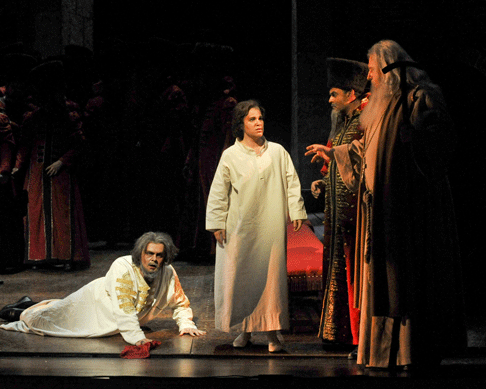 The mad Tsar Boris (Mikhail Kazakov), sensing that death is imminent, prepares his son (Rebecca Jo Loeb) to assume the throne.
The mad Tsar Boris (Mikhail Kazakov), sensing that death is imminent, prepares his son (Rebecca Jo Loeb) to assume the throne.
Mikhail Kazarov was a Boris of unusual depth and warmth. He brought grandeur to the Coronation and made his later suffering near-palpable to the audience. Tenor Yevgeny Akimov moved the growing ambition and shifting fate of pretender Dmitri beyond theatrics, while in her selfish lust for power mezzo Elena Bocharova made Lady Macbeth an amateur. Bass Vitaly Efanov’s account of Russian history from Pimen’s chronicle radiated lyric beauty, and Sergei Leiferkus — the only member of the cast previously well known in the US- was an appropriately cunning Jesuit Rangoni. In this august constellation tenor David Cangeloni acquitted himself admirably as Shuisky, Boris’ No. 1 enemy among the Boyars. For his preparation of the many and massive chorus scenes Alexander Rom would win acclaim at the Bolshoi, and Melinda Cotton had the kids of the Opera’s Children’s Chorus singing Russian as if it were Texan slang.
In sum, an extraordinary performance of a production of Boris so earth-shaking that — one hopes — it will survive many more decades in the world’s opera houses.
Wes Blomster
image=http://www.operatoday.com/BG_13.gif image_description=Mikhail Kazakov as Boris Godunov [Photo © Karen Almond, Dallas Opera] product=yes product_title=Modest Mussorgsky: Boris Godunov product_by=Boris Godunov: Mikhail Kazakov; Marina: Elena Bocharova; The Pretender: Yevgeny Akimov; Pimen: Vitaly Efanov; Varlaam: Mikhail Kolelishvili; Rangoni: Sergei Leiferkus; Shuysky: David Cangelosi; Xenia: Oxana Shilova; Shchelkalov: Andrei Spekhov; The Hostess: Meredith Arwady; A Simpleton: Keith Jameson; Missail: Steven Haal; Fyodor: Rebecca Jo Loeb; A Nurse: Susan Nicely; Nikitich, a police officer: Mark McCrory; Mityukha: Stefan Szkafarowsky; Boyar-in-attendance: Aaron Blake; Khrushchov: Dan Crowell. Conductor: Graeme Jenkins. Original Production: Andrei Tarkovsky. Stage Director: Stephen Lawless. Production Designer: Nicolas Dvigubsky. Lighting Designer: Robert Bryan. Choreographer: Nicola Bowie. Chorus Master: Alexander Rom. Assistant Director: Matthew Ferraro. Children's Chorus Master: Melinda Cotten. Dallas Opera; Winspear Opera House, April 9, 2011. product_id=Above: Mikhail Kazakov as Boris GodunovPhotos © Karen Almond, Dallas Opera
Christopher Maltman, Wigmore Hall
So the first half of Christopher Maltman and Malcolm Martineau’s recital to a crowded Wigmore Hall audience might have been sub-titled.
The sounds and sights of lagoons and piazzas; the glint of the moon on gliding gondolas; lilting barcarolles and strumming mandolins: all were conjured by a varied assortment of songs which threw up some interesting similarities and contrasts.
Fauré’s Cinq mélodies ‘de Venise’ of 1891 are elegant settings of texts by Paul Verlaine; effectively Fauré’s first song-cycle, they are ordered to form a loose narrative and further unified by motivic and harmonic cross-references. Maltman’s relaxed lyricism in the opening ‘Mandoline’ was complemented by Martineau’s lightness of touch as, with remarkable clarity of texture, he mimicked the gentle strains of the plucked mandolin, ‘[jangling] in the shivering breeze’, wonderfully supporting the chromatic meanderings of the vocal line. ‘En sourdine’ (‘Muted’) allowed Maltman to demonstrate both the rich darkness of his low baritone and his masterfully controlled, delicate head voice in the closing lines, when ‘the voice of our despair/ the nightingale shall sing’. After the more urgent, breathless ‘Green’, with its images of a tumultuous beating heart within a verdant, fresh landscape, ‘A Clymène’ opened up more mysterious, ethereal worlds. The ‘mystic barcarolle’ mentioned in the first phrase of the single-sentence text, encouraged Fauré to incorporate a characteristic rocking motif, and the interleaving dialogue between voice and accompaniment was expertly shaped. Maltman achieved a breath-taking beauty, floating the image of ‘Nimbes d’anges défunts,/ Tons et parfums’ (‘haloes of departed angels/ sounds and scents’) before settling into the sweet consonance of the final stanza above soft rippling arpeggios. The final song, ‘C’est l’extase’ (‘It is rapture’) was ardent and impassioned, retreating at the close with the image of a ‘humble hymn/ On this warm evening, soft and low’, the easeful rest conveyed by tenderly oscillating fifths in the piano bass.
Although Schumann’s complementary pair of gondola songs from the Myrthen cycle do not employ the 6/8 meter typically associated with the barcarolle, the dotted, dancing rhythms create a light spirit and energy, which the performers enhanced by moving without a break between the two songs. Maltman seemed more at home with this idiom, carefully shaping the contrasts and drawing out the yearning sections of the texts, with particular effect at the close of ‘Lied II’, elongating the phrases to convey the lover’s desire to ‘flee, my love,/ across the lagoons’, the joyful sentiments of the verse emphasised by the insouciant piano after-phrase. Schubert’s ‘Gondelfahrer’ (‘The Gondolier’) is more earnest, the rich chordal texture, resonant bass melody in octaves with the vocal line, and generally low accompaniment register suggestive of the dark stillness of the deep waters. Setting the same Ferdinand Freiligrath translation of Thomas Moore that Schumann tackled in his ‘Lied II’, Mendelssohn introduced a harmonic richness to convey the burning passion of the eloping lover which Maltman’s fervent vocal colours more than matched.
Reynaldo Hahn’s 1901 cycle, Venezia: Six chansons en dialecte vénitien, brought the Venetian sojourn to an affectionate and blithe close. Settings of simple dialect verse, these songs were first performed by the composer, accompanying himself, propelled across the lagoon by two gondoliers, to the delight of the local passers-by. Joyfully embracing the characteristic meters and figures of the barcarolle, the songs stay just the right side of kitsch or parody. The performers expertly controlled the tempo within and between the songs, pushing on at the close of ‘Sopra l’acqua indormenzada’ (‘Asleep on the water’) as the poet-speaker reflects ‘Ridiadesso e fa l’amor!’ (‘now is the time for laughter and love!’), holding back in the vocalise melismas which conclude the verses of ‘La barcheta’ (‘The little boat’). In these gentle reveries, Maltman revealed a delightful flexibility and delicacy. The more operatic ‘L’avertimento’ (‘The warning’) was followed by erotically charged ‘La Blondina in gondoleta’ (‘The blonde girl in the gondola’). Maltman serenely communicated the tranquil beauty of the scene as ‘Una solo bavesela/ Sventola va I so’ caveli’ (‘Just the suspicion of a breeze/ gently played with her hair’) before the more urgent ecstasies of the final verse: ‘No, mai più tanto beato/ Ai mii zorni no son stà’ (‘Never again was I to be so/ happy in all my life!’). An unfortunate slip at the opening of ironically titled ‘Che pecà!’ (‘What a shame’), did not unsettle Maltman, and he swept rhetorically through this drama of matrimonial disillusionment, the sentiments of the text aptly enhanced by the asymmetrical accents in the piano accompaniment. The final song, ‘La primavera’ (‘Spring’), concluded in a warm blaze of joy.
After the interval, Maltman returned to more familiar territory, although the opening Schubert songs diverted the journey from the Schubertiade’s intimate salons to the public domain of the Italian opera companies that were so popular and successful in Vienna at this time. Composed for the leading bass singer, Luigi Lablanche, the three settings of Pietro Metastasio are far from predictable. ‘L’incanto degli occhi’ (‘The magic of eyes’) drew forth a range of colours and sentiments, from earnest sincerity to impudent playfulness. ‘Il traditor deluso’ (‘The deluded traitor’) places an energetic aria after a rather perfunctory recitative, and Maltman and Martineau successfully created dramatic momentum which climaxed in pulsing octave leaps to convey the melodramatic ‘raging terror’ in the breast of the eponymous anti-hero. ‘Il modo di prender moglie’ (‘How to choose a wife’) displays a surprising Rossinian satirical wit, greatly enjoyed by performers and audience alike.
Although not the most esteemed German Romantic poet, Rückert inspired many of the finest nineteenth- and twentieth-century composers, including Schumann, Richard Strauss, and of course Mahler. Schubert was the first to find the poet congenial, and ‘Du bist die Ruh’ (‘You are repose’) is one of his finest songs: Maltman’s poignant evocation of a quietude troubled by inner pain was deeply moving, and Martineau’s wonderfully judged melodic ornaments enhanced the affecting pathos. The performers relished the challenge of ‘Sei mir gegrußt’ (‘I greet you’) with its recurring refrain, injecting variety and contrast into the repetitions, and maintaining a controlled poise.
With Mahler’s Rückert settings, the evening reached its emotional and musical climax. Maltman utilised all the resources of his diverse baritone, from the airy utterance of the opening phrase of ‘Ich atmet’ einen linden Duft’ (‘I breathed a gentle fragrance’), to the honest directness of imploring command, ‘Love the sun, she has golden hair’ in ‘Liebst du um Schönheit’ (‘If you love for beauty’), to the sombre depths of ‘Am Mitternacht’ (‘At midnight’). Martineau’s alertness, his ability to simultaneously accompany, support, lead and engage with the voice, was superbly demonstrated in these songs. The sparseness of ‘Am Mitternacht’ was enriched by variation of idiom: recitative-like declamation gives way to melismatic outburst, controlled chordal alternations erupt in the final bars to convey the force of the poet-speaker’s declaration of spiritual love.
According to the programme notes, Mahler explained that ‘Ich bin der Welt abhanden gekommen’ (‘I am lost to the world’) was inspired by “the feeling that tills one and rises to the tip of one’s tongue but goes no further”, and the restrained self-possession of this intelligent, emotive performance perfectly captured these sentiments.
A Verdian encore revealed that, despite the rich variety offered to a resoundingly appreciative audience, Maltman has many more musical, theatrical and emotional resources to draw upon.
Claire Seymour
Programme:
Fauré: Cinq mélodies ‘de Venise’; Four Gondoliers’
songs
Robert Schumann: Two Venetian songs from Myrthen
Franz Schubert: Gondelfahrer
Felix Mendelssohn: Venetianesches Gondellied
Reynaldo Hahn: Venezia — Six chansons en dialecte vénitien
Franz Schubert: Three Lieder to texts by Metastasio; Three Lieder to texts by
Rückert
Gustav Mahler: Five Lieder to texts by Rückert
Sonntag aus Licht, Staatenhaus, Cologne
By Shirley Apthorp [Financial Times, 13 April 2011]
Imagine being there for the world premiere of Götterdämmerung. Stockhausen’s Licht cycle is arguably the Ring of our time, and the world premiere of its seventh and final part last weekend in Cologne felt like something so monumentally ambitious that the comparison could hold.
La Clemenza di Tito by Mozart, English Touring Opera, Lyceum theatre, Sheffield
By Mavis Kirkham [The Star, 13 April 2011]
English Touring Opera are to be thanked for giving us the opportunity to hear a Mozart opera which is not often performed.
Still Dangerous After 181 Years?
Most Parisians know the name of the composer Auber only as the name of a metro stop near the Palais Garnier. But Daniel François Esprit Auber (1782-1871) was the most performed French opera composer in the 19th Century and his opera La Muette de Portici (The Mute Girl of Portici) has an important history. The fact that this opera is in the season at the Opera-Comique next year, from the 3rd to the 21st of April, has caused a minor sensation.
When performed in Brussels in 1830, two years after its debut at the Paris Opéra, it was already a European favorite and had established the new genre, “Grand Opera.” The libretto, by Auber’s long-time collaborator, Eugène Scribe, is the story of an abortive attempt by the city of Naples to revolt against Spanish rule. While the chorus represents the oppressed populace, it was actually the duet “Amour sacré de la patrie” ( “Sacred Love of the Homeland”) that caused a riot in the hall. As every Belgian child knows, this immediately became the anthem of the revolution against their Dutch rulers and, some months later, Belgium was an independent country.
What turned heads was the tiny print in the Opéra-Comique brochure indicating that this opera was a co-production with “Théâtre Royal de la Monnaie” — Belgium’s principal opera in the capitol of Brussels, also known as “Koninklijke Muntschouwburg (de Munt)” in the Dutch language. (The opera is located in an area where money was minted in earlier times.) The La Monnaie orchestra will actually be in the pit and the conductor is Patrick Davin, another Belge.
Belgium was annexed by France in 1797, given over to Holland with the fall of Napoleon in 1815 but freed itself of Dutch rule in 1831. It is a parliamentary democracy with a monarch (now Albert II) with limited powers. In 1971, as a result of conflict between the two principal regions, a new confederation of three semi-autonomous regions was created: Dutch speaking Flanders in the north, French-speaking Wallonia in the south with the city of Brussels — mostly French speaking but physically in the area of Flanders — a third region. This federation was created to resolve the political conflicts between the two language regions of Belgium in the 1960s.
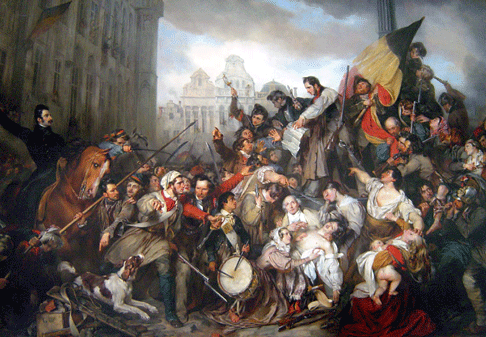 Episodes from September Days 1830 on the Place de l'Hôtel de Ville in Brussels by Gustave Wappers (1803-1874) [Source: Wikipedia]
Episodes from September Days 1830 on the Place de l'Hôtel de Ville in Brussels by Gustave Wappers (1803-1874) [Source: Wikipedia]
These historic conflicts are again a factor in Belgium politics and there are even proponents of dividing the country in two. As a result of these conflicts, Belgium has been unable to form a new government since the last fell in June, 2010 (the previous government remains as a caretaker.) The stalemate marks the longest any state in history has been without a government and many young people, who refuse to accept that Belgium cannot stay united, are protesting. A recent “Nude-in” by students was well-covered by the European media and there is now a Facebook group demanding a new staging of this historic Auber opera.
In any case, this is a political hot potato and an April 7 article in the major Brussels newspaper, La Libre — entitled “‘La Muette de Portici’ Oui, mais pas ici!” (“The Mute Girl of Portici? Yes, but not here!”) the reporter asked a wary Peter De Caluwe, the La Monnaie boss, about his role in this project. De Caluwe, obviously ducking the political issue, spoke of conversations with Jérôme Deschamps who heads the Opéra-Comique. When Dechamps proposed a co-production of an opera by Adolphe Adam, De Caluwe, “amused,” suggested La Muette de Portici instead and Deschamps, unexpectedly, ran with that suggestion, now soliciting a third co-producer: the Teatro San Carlo in Naples. The production will be by Emma Dante, the Sicilian director who staged the politically edgy Carmen of Bizet opening the La Scala season in December of 2009.
The La Libre article concludes: “There is no date planned then for this production on the stage at La Monnaie: nothing before 2015. By that time, we should have a government and, if everything goes well, still a Belgium.”
Frank Cadenhead
Click here for Jan Necker’s article on La Muette de Portici.
image=http://www.operatoday.com/content/Auber.jpg image_description=Daniel François Esprit Auber product=yes product_title=Still Dangerous After 181 Years? product_by=By Frank Cadenhead [This article first appeared in La Scena Musicale] product_id=Above: Daniel François Esprit AuberApril 12, 2011
Soprano Majeski sparks venturesome Civic program
By Lawrence A. Johnson [Chicago Classical Review, 12 April 2011]
The Civic Orchestra served up a tight, 105-minute generally German program with a bit of populist Berlioz thrown into the mix Monday night at Symphony Center.
New opera strives to illuminate the enigma known as Van Gogh
By John von Rhein [Chicago Tribune, 12 April 2011]
BLOOMINGTON, Ind. - Vincent Van Gogh was an opera waiting to happen.
A religious visionary who suffered from epilepsy, syphilis, alcoholism and mental illness for much of his short life (he died of a self-inflicted gunshot wound at 37), the Dutch artist desperately sought acceptance but achieved recognition only posthumously.
April 11, 2011
Daniel Catán, Composer of Operas in Spanish, Dies at 62
By Margalit Fox [NY Times, 11 April 2011]
Daniel Catán, a Mexican composer known for bringing Spanish-language operas into the international repertory, including an adaptation of the film “Il Postino” that starred Plácido Domingo in its world premiere last year, died last weekend in Austin, Tex. He was 62 and lived in South Pasadena, Calif.
Le Freischütz, Opéra Comique, Paris
By Francis Carlin [Financial Times, 11 April 2011]
When the Paris Opera decided to put on Weber’s Der Freischütz in 1841, it commissioned Berlioz to write the recitatives to replace the original spoken dialogue. He agreed but reluctantly; an outspoken critic of meddling with a composer’s intentions, he knew that if he refused, somebody with less respect for Weber would volunteer.
April 10, 2011
Paata Burchuladze, The Tsar’s Bride, London
“Vasily Stepanovich Sobakin”, says Burchuladze, “is a man who has everything, a big family, all his sons happily settled down. He’s a successful merchant in Novgorod and has plenty of money and security. Now his favourite child, probably his only daughter, is engaged to marry the man she loves. So Sobakin is filled with happiness, everything seems just perfect”.
But Marfa Vasilyevna has been seen by Grigory Gryazanoy, the oprichnik. Since he’s above the law he can get what he wants. Lyubasha, his mistress, then resorts to poison. The Tsar Ivan the Terrible chooses Marfa for his bride. Assaulted by this abuse of authority, Marfa and her lover Lykov are destroyed. “Sobakin’s famous Act IV aria, “Zabylasya”, says Burchuladze, “doesn’t last very long, but it’s very touching. It’s poignant because he is expressing a great range of feelings, sorrow, loss and also, anger. Sobakin is a good man, but in this vendetta, he is capable of killing, too”.
The Tsar’s Bride,(Tsarskaya nevesta) is standard repertoire in Russian-speaking countries. Although it’s set in the time of Ivan the Terrible, he wasn’t the only absolutist ruler Russian audiences would have known. Secret mafias, and the arbitrary misuse of power weren’t a monopoly of the Tsars. Burchuladze grew up in the Soviet Union and recognizes the significance. “This production” he says “isn’t set in the ancient past”. Although there are numerous recordings of this opera, western audiences may not have experienced it live. Perhaps they shouldn’t come expecting decorative “Russianism”, but to hear how Rimsky-Korsakov shapes the drama through his music. The director, Paul Curran, has worked with the Kirov and Mariinsky, and appreciates the context.
Burchuladze made his debut at the Royal Opera House in London as Ramfis in Verdi Aida with Luciano Pavarotti. Katia Ricciarelli and Zubin Mehta. He was a sensation. “What can I tell you about Pavarotti ?”, sighs Burchuladze, with feeling. “He was a big man, his body was big but also his heart. Everything about him, was open and warm. I was only 30 when I sang that Ramfis and he was a huge star but he looked after me. We worked together in Vienna, in the US, many times. Pavarotti was so technically wonderful that there was no limit to his singing. He could open up his whole persona. He was the best person in my life”.
Burchuladze himself is an open-hearted personality. “ I love to sing, I live to sing”, he says. “When you go on a stage, you must enjoy what you are doing, or the public won’t enjoy it. I love to sing roles that I can identify with and express their feelings”. Favourite roles are Attila, Philip II, Mefistofele, Zaccaria in Nabucco....”. His eyes light up as he lists the parts. “I like strong, passionate characters” he smiles, “but I also like buffo, like Don Basilio and wonderful fantasies like Rimsky-Korsakov’s Le Coq d’Or.“ Next season, he’s singing The Legend of the Invisible City of Kitezh. .
He also has a lot of respect for Boris Gudonov, with whom he’s so closely associated that he’s created the role in nearly every major opera house around the world. “Boris is a good man”, says Burchuladze. “Nobody knows if he killed the Tsarevich. Maybe he just thought about it and his followers did the work. But Boris feels guilt. He feels sorry for what has happened. So many people with that kind of power have no conscience. They kill and hurt people without any responsibility. Boris gets depressed because he knows right from wrong. That’s why he’s a good person”. Similarities with the situation in The Tsar’s Bride are not amiss.
With Pavarotti, Burchuladze recorded Aida (La Scala), Nabucco (Verona), and Ernani (Bonynge, WNO) but his experience is far more extensive. He’s recorded a lot of Mussorgsky, for example, including with Abbado in Vienna. His reputation rests both on Russian and Italian repertoire, and on Mozart. Born in Tblisi, he trained first in the Georgian Conservatoire, and in 1979, aged 24, moved to Milan, where he studied under Guilietta Simionato.
Although Burchuladze’s mother was a keen amateur pianist, he initially studied engineering at University. “I wanted to build things, like my father”, he says. One day, though, he was asked to sing at the conservatoire and suddenly realized that singing would be his future. “Once you get applause on stage, you’re hooked forever!”
Although Tblisi is still his home, he doesn’t teach. “It’s not fair on students” he says, “students need a teacher around all the time, and I’m always travelling, so I couldn’t give them the attention they need”. This steadiness matters a lot to him. As a young man, Herbert von Karajan described Burchuladze as “The Second Chaliapin”. It was a sensation but a mixed blessing. “When one legend compares you to another legend, it’s a lot to carry on your shoulders. People don’t expect you to be yourself”.
Burchuladze models himself on consistency. “I want to be singing for 50 years, so I pace myself. Seven or eight years ago I was singing Zaccaria in Japan. There were two alternate casts and the other singer was Bonaldo Giaiotti. He was 72 years old at the time and still singing one of the most difficult parts for our voice type, and he sang it perfectly. I can’t imagine life without singing, so I want to be like that. By the time I reach 72, I will have had 50 years as a professional. That’s something that would make me very happy”. After The Tsar’s Bride in London, he has a full schedule ahead, including a gala with Plácido Domingo and opera appearances all over the world, so chances are Burchuladze will achieve that dream.
Anne Ozorio
For details of Rimsky-Korakov The Tsar’s Bride at the Royal Opera House, London please see the ROH site. The production runs from 14th April to 2nd May 2011.
For details of Paata Burchuladze’s career, please see his website.
image=http://www.operatoday.com/Burchuladze_headshot.gif
image_description=Paata Burchuladze [Photo courtesy of Askonas Holt]
product=yes
product_title=An Interview with Paata Burchuladze
product_by=Interview by Anne Ozorio
product_id=Above: Paata Burchuladze [Photo courtesy of Askonas Holt]
April 8, 2011
Tosca, NI Opera
It’s what happened to Northern Ireland Opera, however, on day two of its Tosca staging, when a device planted by dissident terrorists (the second in five days) forced the rapid abandonment of St Columb’s Cathedral in Londonderry, the Act One venue in this site-specific staging. The show did indeed go on: Act One as a concert performance, Acts Two and Three in the city’s Guildhall and St Columb’s Hall, as scheduled. “We were prepared and decided we were going to go ahead with it anyway”, commented conductor Nicholas Chalmers stoically. “We will not be beaten”.
Artistically the production was a triumph. Its keynote was the studious avoidance of all the blowsiness and bombast which can reduce Tosca to the “shabby little shocker” of operatic legend. Oliver Mears’s staging had shock without shabbiness: in calm, clinical fashion he cut to the political quick of the drama, the raw ingredients of political struggle, state oppression, torture, murder, suicide and religion starkly anatomised in a city where for the thirty years of “The Troubles” (Northern Ireland’s vicious sectarian conflict) they were the lingua franca of everyday existence. A Tosca with contemporary relevance? Just a little…
 Oliver Mears
Oliver Mears
Act Two’s extended confrontation between Tosca and police chief Scarpia was in this respect seminal. Belfast-born Giselle Allen, in her first Tosca, delivered an already sharply modulated and nuanced reading of the part, unleashing fulsome waves of tone in the most straitened outbursts, retaining poise and focus in quieter, self-confessional passages. No surprise to learn that she is already an acclaimed Jenůfa. The Scarpia, Paul Carey Jones, was a study in restrained menace, cold, icy, vocally unhistrionic — and pretty scarifying. Mears utilised the given space (the sober wood-panelling and civic symbols of Derry City Council’s building) superbly: the attempted rape happened within touching distance of the front-row spectators, blood spurted graphically in front of their noses from the stabbing, and audience members filed past the still visible body of the butchered Scarpia, prostrate on a committee table at floor level, to get their interval refreshment. “Strong stuff”, a man next to me commented, adding a pointed reference to a notorious police interrogation centre in Northern Ireland. I said nothing.
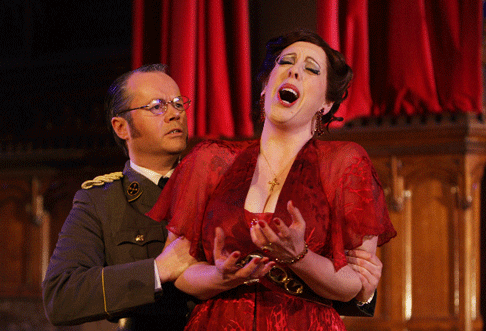 Giselle Allen as Tosca and Paul Carey Jones as Scarpia
Giselle Allen as Tosca and Paul Carey Jones as Scarpia
Earlier Mears had used a completely different logistical lay-out for Act One in St Columb’s Cathedral, the orchestra deployed in a side chapel and behind the altar, the aisle a conduit for the arrival of the dramatis personae and the excellent choir of local schoolchildren who intoned the “Te Deum” lustily, encouraged by the vividly comic and firmly voiced Sacristan of Cork baritone Brendan Collins. Mexican tenor Jesús León, slightly stiffer and less stage-confident than his Tosca, had handsome features and a pleasingly sappy upper voice going for him. His Cavaradossi was brooding, perhaps a touch too interiorised for effective projection. He rose to Act Three’s “E lucevan le stelle” (in English), sung in a cramped, grubbily-tiled police execution chamber where Mears had earlier staged a shockingly literal dumb-show shooting over Puccini’s lengthy orchestral introduction. I wondered what my interval interlocutor might be thinking.
The production as a whole was the very opposite of opera as commodification: there was no desire evident to cushion the rawness of the narrative content, no truck with the idea of opera as plush, comfortable middle-class entertainment. This was Tosca as riveting political drama, visceral without being in any way artificially pumped-up or gimmicky. It made the work seem like a truly great opera, rather than one which is merely massively popular. The audience stood as one at the end, noisily acclaiming what was undoubtedly a momentous evening for Northern Ireland Opera, in a part of the United Kingdom which has been on short (often non-existent) rations operatically throughout its ninety-year history. The new company’s first full (2011-12) season is awaited with the keenest interest.
Terry Blain
image=http://www.operatoday.com/Tosca_pic-2.gif image_description=Giselle Allen as Tosca and Jesus Leon as Cavaradossi [Photo courtesy of NI Opera] product=yes product_title=Giacomo Puccini: Tosca product_by=Floria Tosca: Giselle Allen (31st March/2nd April) Lee Bisset (1st April matinee performance); Mario Cavaradossi: Jesus Leon; Scarpia: Paul Carey Jones; Sacristan: Brendan Collins; Angelotti: John Molloy; Spoletta: Andrew Rees. Director: Oliver Mears. Conductor: Nicholas Chalmers. Designer: Simon Holdsworth. Lighting Designer: Kevin Treacy. product_id=Above: Giselle Allen as Tosca and Jesus Leon as CavaradossiPhotos courtesy of NI Opera
April 6, 2011
Capriccio, Metropolitan Opera
In fact, as they both surely knew, poets are thrilled when a composer sets them to music and opera composers treasure a good librettist, as no one did more than Strauss, deeply upset when the Nazis drove his Jewish collaborators into exile.
In Capriccio, the opera they concocted, the artifice of the contest is given a dramatic turn of the screw: Countess Madeleine, the elegant heroine, is amorously besieged by a poet and a composer who are, therefore, at daggers drawn. When the poet writes her a sonnet, the composer turns it into a song. The poet fights back by inserting the piece in a poetic drama. An impresario resolves to stage it with Paris’s leading actress, and Madeleine’s brother, who is pursuing that lady, volunteers to appear in it (and pay for it). There will also be dancers (since this is France) and even some money-grubbing Italian singers (because … why not?), and a whole lot of sophisticated banter about art, the arts, and the heart. Oh, and a bunch of menservants between scenes to provide scabrous commentary on the affectations of their betters. Plus a sleepy prompter to remind us that the public often misses the real work being done backstage. It is music-drama as Viennese pastry: Form follows anything but function, but the result is miraculously filling. Strauss thus got a chance to bring his career to a perfect conclusion—not a swan-song so much as a dessert—it was his last essay in the operatic form though he produced other music till his death six years later.
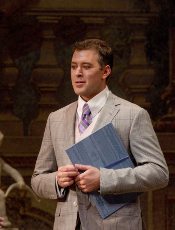 Joseph Kaiser as Flamand
Joseph Kaiser as Flamand
Strauss’s operas are of two kinds—most of them both at different moments—the talky operas (Die Schweigsame Frau; Intermezzo) and the lush, lyrical ones (Die Frau ohne Schatten; Daphne). The best of them straddle the two states, easily (Ariadne; Rosenkavalier) or uneasily (Salome; Arabella). Capriccio is talky, but the talk is about matters lyrical and the lyricism shines through at every opportunity, like a light glowing through the cracks in ragged scenery. It’s a hefty, two-and-a-half-hour intermissionless evening (when the Met last gave it, there was an intermission, because Kiri Te Kanawa insisted), but it couldn’t be by anyone but Strauss, and if you have the proper orchestra (the Met has, led by Andrew Davis) and cast (the Met mostly has), it’s as enjoyable as a long, heavy Central European dinner with many champagne toasts to accompany the different courses.
One mild awkwardness: For reasons unclear (Robert Perdziola’s costumes?), John Cox’s production in Mauro Pagan’s magnificent trompe l’oeil drawing room has been set in Paris of the 1920s, though Krauss and Strauss carefully filled the libretto and the score with in-joke references to Paris of the 1770s, when they set it. The 1770s was the era when (survivors said, after the Revolution) the sweetness of life reached its peak, when Clairon ruled the stage and Gluck the opera. Clairon is a character here, and there is much talk about Gluck and Voltaire and Rameau, and of everyone appearing (or not appearing) at the royal court, none of which makes sense in the republican 1920s. (And would one, in the latter period, discuss drama versus music in the theater and never mention Wagner or Debussy? In Paris?) So we are obliged to ignore the libretto at such times, tragic as that is for so careful and literate a piece of work, and enjoy the quotations from Gluck’s Iphigénie, and sigh for the good old days when opera direction made sense.
It may have been a mistake for me to listen to the first performance of this run of Capriccio on the air, via the free broadcasting service available on the Met’s web site: The voices all sounded impossibly strong, the score wonderfully lush, and I looked forward to kicking back and letting the Straussian surf waft me to Nirvana. In the theater, though, I found the voices far less sumptuous, less physically present. The conversation was favored; the lyricism faded out. Thus, for example, Joseph Kaiser, a young tenor I’ve admired in other roles, sang Flamand the Composer ardently and enthusiastically but made little that was distinctive of his role. Russell Braun, as Olivier the Poet, might have been, in fact, conversing not singing (and he does recite his sonnet). Peter Rose, who captivated the Met as Bottom in Midsummer Night’s Dream among other roles, was a splendid buffo presence without giving much sensual pleasure as La Roche, the impresario. Sarah Connolly, as Clairon, perfection last year as the Composer in Ariadne, was hampered by a costume and fright wig that made her look like one of Samantha’s aunts from Bewitched, and sexy, innuendo-fraught witticisms fell flat from such a figure. Stage direction that distracted her every move with the witty dancing of Jennifer Goodman cannot have helped her. The self-parody of Olga Makarina and Barry Banks as the hungry Italian singers earned most of the vocal interest of the show.
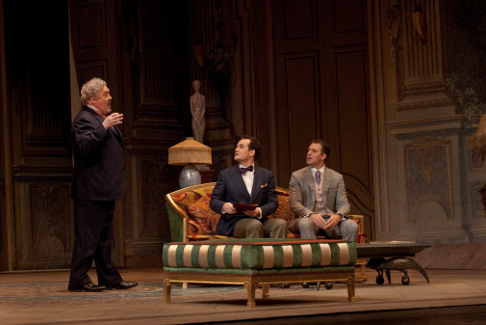 (right to left) Joseph Kaiser as Flamand, Russell Braun as Olivier and Peter Rose as La Roche
(right to left) Joseph Kaiser as Flamand, Russell Braun as Olivier and Peter Rose as La Roche
That leaves, as the plot does, the Countess Madeleine of Renée Fleming. Capriccio is the Countess’s show, her chance to fill the shoes (or shall we say culottes?) of Mozart’s Countess and Strauss’s Marschallin and Arabella (a countess by birth)—all of them roles Fleming has sung here with honor. Strauss, indeed, is one of the composers for whom she has the greatest natural affinity. She looked splendid in the rather awkward costumes—would a lady this classy really change into a glittery silver ball gown to dine alone?—and her interactions in the salon scenes, her amused, tolerant bewilderment at the two declarations of love, her grace to her guests, her juggling of the situation were superbly handled—Kitty Carlisle Hart set to music. We understood why all these people loved her, were thrilled to be with her, to perform for her. She sang the varying phrases with distinction, lyricism salted with witty banter.
So to the long final scene, where she is alone with a mirror, an invisible mirror the director has hung on the fourth wall, so that she must peer into it and, descrying her inner self, present that self to us. This scene is a meditative tour de force, considerably more introspective but also less intense than the meditation of Thaïs, another Fleming-with-a-mirror role: After all, her immortal soul is not at stake here, whichever fellow she chooses by eleven o’clock the next morning. The dalliance may not even last. Too, in the French manner, she may decide on simultaneous affairs with both, or at least simultaneous flirtations. Fleming has sung this meditation often, on disc, in concert, at the Met Gala. Perhaps that is why, after a night on her best, most musicianly behavior, acting the role and singing the words, she slips back into bad habits in the last minutes, slurping and cooing where Strauss meant his music to be precise, dreamy, yes, and well acted, but precise. It was a reminder of Fleming the gifted but self-indulgent musician, who could have been but is not the great American diva of our time.
John Yohalem
image=http://www.operatoday.com/CAPRICCIO_Fleming_as_Countess_5815a.png image_description=Renée Fleming as Countess Madeleine [Photo by Ken Howard courtesy of The Metropolitan Opera] product=yes product_title=Richard Strauss: Capriccio product_by=Countess Madeleine: Renée Fleming; Clairon: Sarah Connolly; Flamand: Joseph Kaiser; Olivier: Russell Braun; La Roche: Peter Rose; Count: Morten Frank Larsen; Italian Singers: Olga Makarina, Barry Banks; Dancers: Jennifer Goodman, Griff Braun. Metropolitan Opera Orchestra conducted by Andrew Davis. Performance of April 1. product_id=Above: Renée Fleming as Countess MadeleineAll photos by Ken Howard courtesy of The Metropolitan Opera
April 5, 2011
Die Kluge/Mesdames de la Halle, Zurich Opera
By Shirley Apthorp [Financial Times, 5 April 2011]
Does Carmina Burana deserve its popularity? Certainly history has dealt less kindly with the rest of Carl Orff’s music, and his operas remain obscure. Thanks to a bold double bill from Zurich’s international opera studio, listeners have the chance to assess Die Kluge (The Wise Woman) for themselves.
April 4, 2011
Monodramas, NYCO
John Zorn’s La Machine de l’être (The Machine of Being) began with an empty stage gradually filling with silent individuals dressed in all-covering costumes resembling burqas. A man and a woman dressed modern formal wear with stark white shirts and ties moved among the growing throng. One of the burqa-d women darted away when approached, as if in fear, then disappeared into the crowd, giving the proceedings something of the feel of a video game. The actors in suits removed the burqas from two of the crowd to reveal, first, a man dressed in a painfully brilliant red suit, and second, the soprano dressed in a starkly white gown. It was unsettling to find a man under a burqa, and he remained an uncomfortable presence on stage. A large cartoon “speech balloon” rose out of the floor and into position just over the head of the darting woman, adding to the video game impression. Film clips of drawings adapted from those made by Antonin Artaud during his incarceration in an asylum played across the balloon. These disturbing drawings complemented the disjointed music as both became increasingly twisted and tortured. Finnish soprano Anu Komsi, in her City Opera debut, did a fine job tossing her voice in the air evoking a descent into madness in this free-form piece that lacked both text and plot.
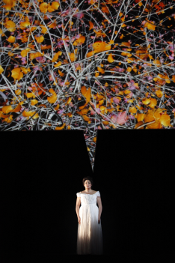 Kara Shay Thomson, soprano
Kara Shay Thomson, soprano
During a riveting entr’acte, Jennifer Steinkamp’s stunning video display of a stylized forest moving through the seasons played across the cartoon balloon. The video began with a wild profusion of pink cherry blossoms mixed with yellow flowers and moved on to greens of summer, then orange leaves falling and blowing and leaving a gray tangle of bare branches. I was almost disappointed when the second Monodrama began.
But the gorgeous orchestrations of Schoenberg’s Erwartung soon enveloped the audience, pulling us into the depths of the lonely protagonist’s consciousness. A stunning blizzard of brilliant red leaves fell on the stage for over half of the 30-minute piece. The glittering, tumbling red was mesmerizing against the midnight blue backdrop. A dead man lay in the middle of the stage with a knife protruding from his chest while the tortured ravings of the soprano, sung movingly by Kara Shay Thomson, were all that was needed to explain the drama—but several dancers provided an unneeded distraction throughout this beautiful and compelling operatic piece.
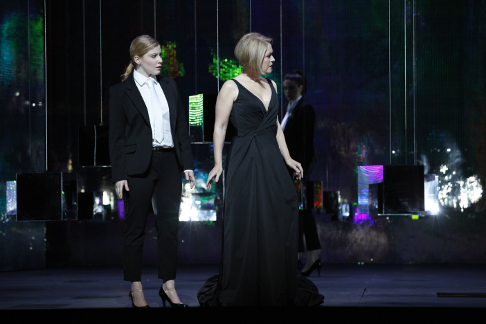 Cyndia Sieden and ensemble
Cyndia Sieden and ensemble
The final, longest, and most abstract Monodrama of the evening was Neither, set by composer Morton Feldman to a text by Samuel Beckett. The mystical and complex orchestral part was richly complemented by the continually evolving splashes of intense colors and shapes created by the laser and holographic effects (after work by the innovative laser artist Hiro Yamagata). Mirrored one-foot cubes moved and revolved, sending flashes of color and penetrating lights across the house. The singer and the several dancers reacted to and interacted with the cubes, as the singer seemed to try to find some connection with the other people. Cyndia Sieden’s voice sailed above the orchestra, intoning the text in a near monotone that never left the highest extremes of the soprano range.
The City Opera is certainly to be commended for stepping beyond the traditional operatic comfort zone to present these three fascinating and compelling performance pieces. It bodes well for the future of opera as a living art that this company has brought such work to its audience.
Jean Andrews
image=http://www.operatoday.com/Monodramas0020.png image_description=Anu Komsi [Photo by Carol Rosegg courtesy of New York City Opera] product=yes product_title=Monodramas product_by=John Zorn: La Machine de l’être — Anu Komsi, soprano. Arnold Schoenberg: Erwartung — Kara Shay Thomson, soprano. Morton Feldman: Neither — Cyndia Sieden, soprano. New York City Opera orchestra conducted by George Manahn. Performance of March 31. product_id=Above: Anu KomsiAll photos by Carol Rosegg courtesy of New York City Opera
L’Elisir d’Amore
(Doubtful, though, is Emilia Branca’s tale that Donizetti complained of a Dulcamara with a “voice like a goat.”) Notwithstanding the shortcomings of the singers, the score won the day.
Could it have been otherwise? L’Elisir is so ingenious, so bubbly, so amusing—and at the same time so moving and heartfelt—that it proved a huge and instantaneous success. It charged confidently into the international repertory and never lost steam. Nearly two centuries later, it’s still almost impossible to botch L’Elisir beyond redemption. And so it is with New York City Opera’s production: carried by Donizetti’s brilliant music, Romani’s witty and singable verses, an attractive production, and a much more than “passable” tenor, the performance I attended delighted even as it disappointed.
To a modern audience, the American Southwest during the 1950s seems a remote and idyllic time, and Jonathan Miller’s 2006 production therefore neatly fit the spirit of the piece; every detail was skillfully thought out and Isabella Bywater’s sets and costumes were a delight. The locus is Adina’s Diner, the gathering place of choice for a desert community near a military base. Dulcamara rolls up to the gas pumps in a vintage hotrod, sporting spectator shoes; Nemorino wears mechanics togs; the chorus consists of greasers, fry cooks, soldiers and women in poodle-skirts and cat-eyed glasses. Adina is a sort of Marilyn Monroe, Giannetta a less prominent Maureen O’Hara. Belcore struts around in a Marine uniform and indulges in Elvis-like pelvic gyrations.
The direction of this revival left much to be desired, and seemed motivated more by a desire for cheap laughs than by an understanding and appreciation of the text. As Donizetti’s biographer William Ashbrook observed, the most groundbreaking feature of L’Elisir is that it is not mere slapstick, and its lieto fine occurs because Adina realizes Nemorino’s true goodness and sincerity; L’Elisir succeeds because there is real emotional depth here.
With all this in mind, let it be admitted that Nemorino is not the sharpest knife in the drawer; but for Romani he is a gullible, uneducated country lad with a big heart. In the Miller production he is painted as borderline developmentally disabled. He claps gleefully, jogs in place, bats imaginary balls and jumps up and down as if he were five years old, much of the time wearing a dopey expression. In line with disturbing current trends, excessive stage action often interferes with some of the most important musical and dramatic moments. During Adina’s solo in “Chiedi all’aura lusinghiera,” Nemorino unwittingly spills salt, tossing handfuls around as Adina tries frantically to clean it up. During her duet with Dulcamara (dramatically the turning point of the opera), Adina reaches so deeply into his pocket that his expression plainly tells us where her hand has wandered. In the women’s chorus that begins Act II, a toilet flushes as they stand in line waiting for the restroom, provoking a few nervous scatological giggles; later Nemorino, sickened by his excessive consumption of the “elixir,” runs to the same bathroom to be sick.
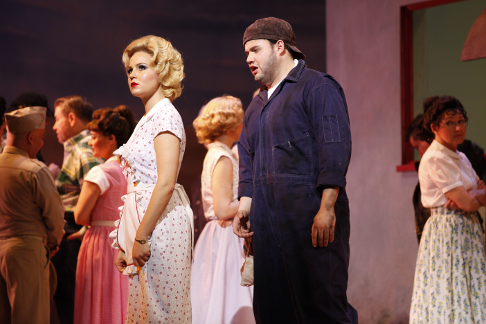 Stefania Dovhan as Adina and David Lomelí as Nemorino
Stefania Dovhan as Adina and David Lomelí as Nemorino
This is all a shame, but even this cloud of directorial dust, tenor David Lomeli was able to show Nemorino’s passionate nature, his innocence and his vulnerability. Indeed, only his artistry raised the afternoon out of vocal mediocrity. Lomeli never lost sight of what makes Nemorino such a sympathetic character, even as he acted the fool. He sang a wistful “Quanto e bella,” and his impassioned solo passage, “Adina, credimi,” in the first act finale tugged at the heartstrings. An achingly tender, beautifully shaped “Una furtiva lagrima” earned him the loudest cheers of the evening. Lomeli has a lovely, light voice with varying colors and a good sense of how to use dynamic shading; there is a beautiful, genuine Italianate squillo there too. He warmed up quickly after a slightly underpowered start, and hit his stride with full confidence by the time of his duet with Dulcamara.
As Adina, Stefania Dovhan was less than ideal casting. She is physically very attractive, and the voice is intermittently beautiful and expressive, but on the whole it is too harsh and inflexible for the role. Her voice doesn’t have much color; her acuti, while on pitch, were rather grating, and she does not handle coloratura cleanly. Though there were isolated moments of real feeling, for the most part it was a flat, rather riskless portrayal; the shift from fickle and vindictive vixen to loving fiancée was a bit too abrupt and not very convincing.
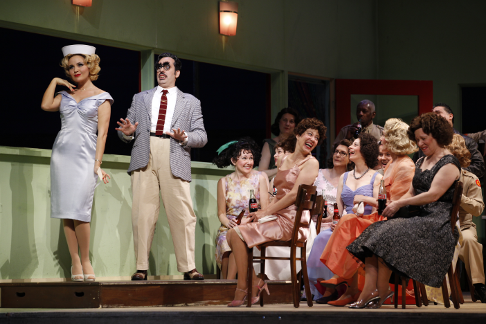 Stefania Dovhan as Adina and Marco Nisticò as Dulcamara
Stefania Dovhan as Adina and Marco Nisticò as Dulcamara
As for José Adán Pérez’s Belcore and Marco Nisticò’s Dulcamara, all their comic silent-movie face-pulling and pelvic thrusts couldn’t hide the fact that they sounded vocally undernourished and fudged the coloratura. In his duet with Lomeli, Nisticò’s vocal line drowned beneath his partner’s. Brad Cohen conducted a brisk if at times somewhat hurried performance. The orchestra sounded marvelous but for one horn mishap. The chorus was well-rehearsed and in fine form.
Daniel Foley
image=http://www.operatoday.com/Elixir0001.png image_description=Stefania Dovhan as Adina and Meredith Lustig as Giannetta [Photo by Carol Rosegg courtesy of New York City Opera] product=yes product_title=L’Elisir d’Amore product_by=Adina: Stefania Dovhan; Giannetta: Meredith Lustig; Nemorino: David Lomeli; Belcore: José Adán Pérez; Dulcamara: Marco Nisticò. Brad Cohen, Conductor. Jonathan Miller, Production Designer. Isabella Bywater, Set/Costume Designer. New York City Opera, March 26, 2011. product_id=Above: Stefania Dovhan as Adina and Meredith Lustig as GiannettaAll photos by Carol Rosegg courtesy of New York City Opera
Lawrence Zazzo, Wigmore Hall
Both performers may be alumni of King’s College Cambridge, but there was little of the English cathedral tradition in either the selected repertoire or the performance itself. Indeed, in a recent interview, Zazzo declared his intention to “push the envelope in terms of what countertenors can do” not just in terms of “different repertoire or singing higher, but showing that you can give a rounded performance that's acceptable on all different levels”.
Zazzo has received immense praise for his recent operatic portrayals — in Xerxes and Radamisto at ENO and in Thomas Adès’ The Tempest at Covent Garden, where he created the role of Trinculo — and there was certainly an air of excitement as the performers bounded onto the stage and launched precipitously into the Charles Ives’ ‘Memories’, commencing even before the welcoming applause had ceased.
Divided into two parts, ‘A) Very pleasant’ and ‘B) Rather sad’, ‘Memories’ is one of Ives’ most famous comic songs. Bursting with energy, Zazzo captured the breathless excitement of the young protagonist who eagerly awaits the rise of the curtain at the opera house. The song is a witty parody of G&S patter, and Zazzo enjoyed the flamboyant exaggerations of the song. However, here and in the quieter, more melancholy ‘Rather sad’, the qualities which were to mar what was at times an impressive and striking performance were immediately present. For Zazzo’s countertenor is a rather cold, hard instrument — suitable perhaps for Ives’ sharp satire, but less appealing at more reflective moments. Moreover, the text was almost unintelligible, here and throughout the recital, as Zazzo continually elongated the vowels and swallowed or ignored the consonants; this created the impression of a lack of emotional involvement with the text, as verbal nuances were not distinguishable, an effect exacerbated by a rather inflexible approach to the delivery and shaping of the melodic phrase.
The performers certainly shared an innate feeling for Ives’ varied idioms. ‘Songs my mother taught me’ possessed a controlled simplicity; in ‘Walking’ Lepper vigorously conjured up the sounds and rhythms of everyday urban life, church bells, a jazz dance, surging traffic. Most successful of these opening songs was ‘The Housatonic at Stockbridge’: here the strumming piano chords conveyed the many colours and translucency of the ‘cloudy willow and the plumy elm’ beside the ‘dreamy realm’ of the ‘contented river’. As the Housatonic River meandered its way through the landscape, the power and penetration of Zazzo’s focused tone was apparent, although a tendency to crescendo rather too forcefully through particular syllables at times revealed a slight graininess.
Samuel Barber’s ten Hermit Songs of 1952 are scarcely, if ever, performed by a countertenor. The texts, as Barber explained are “settings of anonymous, Irish texts of the eighth to thirteenth centuries written by monks and scholars, often on the margins of manuscripts they were copying or illuminating — perhaps not always meant to be seen by their Father Superiors”. And, the songs are principally declamatory in nature; indeed, the composer eschews time signatures in order to allow the singer to declaim the rhythmic irregularities of the poetry. The archaisms of the texts are underlined by sparse textures and frequent bare fourths and fifths in the accompaniment — as in ‘The Crucifixion’, where the driving intensity of the painful image of suffering, ‘Ah sore was the suffering borne/ By the body of Mary’s Son’, is counterbalanced by a quiet piano postlude whose high register and bare fifths evoke the poignancy of the grief, ‘Which for His sake/ Came upon His Mother’.
Zazzo’s intonation was well-centred throughout these songs, and at times he responded very effectively to textual details — delivering a whirling glissando to convey the sound of the bell struck ‘on a windy night’ in ‘Church bell at night’, and emphasising the dynamic melismas in ‘Sea-snatch’ to imitate the apocalyptic wind which as ‘consumed us, swallowed us’, culminating in a piercing cry to ‘O King of the starbright Kingdom of Heaven’. In the enigmatic, ephemeral ‘Promiscuity’, he revealed a more subtle and varied palette; while at the climax of ‘St. Ita’s vision’ Zazzo’s astonishing range, and his ability to control his voice across the registers, was unveiled. Throughout these songs, Lepper exploited contrasts of register and brought vitality to the rhythmic irregularities. Zazzo, a natural stage performer relished the dramatic quality of the songs, readily adopting different personae, and bringing the characters and lives from the medieval past into the present, revealing the on-going relevance of the texts’ sentiments in the modern world.
The second half of the recital began with Ned Rorem’s War Scenes of 1969, settings of Walt Whitman’s diary of the Civil War, ‘Specimen Days’. In these recitative-like declamations Zazzo’s imprecise diction was a more serious problem, although some songs were more successful in this regard than others. In ‘Specimen Case’, steady piano chords punctuated a clearer account of the war-shock suffered by a ‘poor youth, so handsome, athletic, with profuse shining hair’, and here Zazzo established a mood of pathos and regret. Similarly, the unaccompanied opening of ‘The real war will never get in books’ (which Rorem gives the unusual marking, ‘flexible, declamatory, slower than speech, but rich and full, supple and grand’) was deeply moving. Humming through closed mouth for the final phrase, allowing his voice to dissolve as we pondered on ‘how much, and of importance, has already been, buried in the grave’, Zazzo showed that he is not afraid to take risks and experiment with colour — here to touching effect. And, in ‘A night battle’ the shout, ‘Charge men charge?...’ was extravagantly delivered. Rorem’s accompaniments do much to convey the drama of the prose, and at the start of this song Lepper sensitively interweaved the right hand line with the voice, while an ethereal concluding flourish evoked the silvery radiance of the moon at dusk. The grotesque fury of the postlude to the jazz inflected ‘Inauguration ball’ was startling.
Zazzo concluded this all-American programme which a new song-cycle by Andrew Gerle, ‘Drink Well and Sing’, based on poems by, and inspired by, Anacreon of Teos. It concerns a poet at the end of his life, as he reflects on his lost youth and consoles himself with thoughts of wine, women and song. Gerle is best known, and highly acclaimed, for his music theatre work — the composer of six highly praised musicals, he is a recipient of the Jonathan Larson Award, three Richard Rodgers Awards, and was the first composer selected to receive the Burton Lane Composer's Fellowship from the Theatre Hall of Fame. And, there were plenty of Broadway touches here, not least in the boisterous ‘Bring me the winebowl, in which Zazzo enjoyed the extravagant rhetoricism, relishing the strident semitonal dissonances between piano and voice. Affective ‘blue notes’ coloured ‘Once again’, a lament for lost love and passing years: ‘And she tells me that my hair is white,/ And say oh!/ She loves another’. As in the Rorem songs, the piano does much to relay the narrative. In ‘You’ve snipped the perfect blossoms off’, Lepper expertly controlled the momentum, manipulating colour, dynamics and rhythm, interweaving sensitively with the vocal melody. The staccato stabbings of prancing horses, added much wry irony to the miniature, ‘The Mysians’: ‘The Mysians first mated/ Horse-mounting asses with mares/ Inventing the half-assed mule.’ The gentle lilting accompaniment of ‘Before I depart’ brought the cycle to a restful close, as the poet-speaker longs to ‘make a bed of soft myrtles and lotus plants,/ And drink to my friends’.
This was an intriguing and entertaining evening of song; Zazzo demonstrated an admirable seriousness and considerable musical intelligence in committing so much complex material — music and text — to memory, especially in the second part of the performance. However, these cycles are particularly dependent on clear enunciation of the text for their full impact to be felt, and in this regard there is still some work to do.
Claire Seymour
Programme:
Ives: Memories; Songs my mother taught me; Walking; The Housatonic at
Stockbridge.
Barber: Hermit Songs Op. 29.
Rorem: War Scenes.
Gerle: Drink Well
and Sing.
Literalism and Truth: Fidelio, Royal Opera
A straightforward reading of Fidelio is almost a contradiction in terms. The real message is hidden, just as Florestan is hidden, because it’s too dangerous to contemplate. In 1805, the idea that one woman could bring down the system was so unlikely that an authority figure like Don Fernando had to be introduced to make the plot feasible. He’s benevolent but still an Enlightenment despot. Beethoven and his audiences were not naive. They know all too well that Leonore is theory made narrative. Symbolic, not reality.
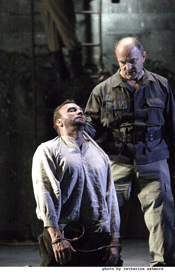 John Wegner as Don Pizarro and Endrik Wottrich as Florestan
John Wegner as Don Pizarro and Endrik Wottrich as Florestan
Florestan is more than a prisoner, or even an ordinary man. He’s an embodiment of “Der Edle, der für Wahrheit stritt” (the noble spirit that strives for Truth). Political and philosophical concepts are so fundamentally part of the meaning of this opera that any production that downplays the issues is a betrayal of what Beethoven believed and what the opera is really about.
Jürgen Flimm, however, takes a unswervingly literal approach, without irony or insight. No political or radical passions here. The prison isn’t a mirror of society so much as decoration. Leonore (Nina Stemme) unlocks the cell doors, and out the prisoners pop, meek and mild. Anyone with experience of prisons, even “nice” ones, knows they’re bursting with suppressed violence. So the wonderful chorus “O welche Lust, in freier Luft Den Atem leicht zu heben!” is glorious, but it’s meant to be poignant and symbolic, not literal. Things don’t change so easily. But Beethoven knew the sublime music would have an emotional effect on his listeners. Spurred into sympathy, audience attitudes might change. Only then would there be any chance of real liberation.
Fidelio is a notoriously difficult opera to stage, but there are clues in the music as well as in the stage directions. Beethoven’s Third Symphony (Eroica) is more than a random arrangement of abstract sounds. So Fidelio with its text is even more explicitly concerned with ideas beyond music. It’s much more than a narrative and clues to its meaning are embedded in abstract sound. Fidelity to the script, in the case of Fidelio, means paying attention not just to the words but to what’s happening beneath the surface making the story what it really is.
Leonore’s music in the first scenes is agitated, conveying a sense of entrapment. Yet Stemme is directed to move from one side of the stage to another, dissipating the tension. Fortunately Stemme, like Leonore, has integrity and the stage nous to sing more acutely than she might normally. She inhabits character rather than making sounds for the sake of sound. Her movements are like those of a wild bird, which cannot be caged and seeks freedom. Whether this was in Flimm’s direction, or an idea by Daniel Dooner, revival director, or Stemme’s natural instincts as actress, I don’t know. But she’s able to express more than what’s strictly in the score.
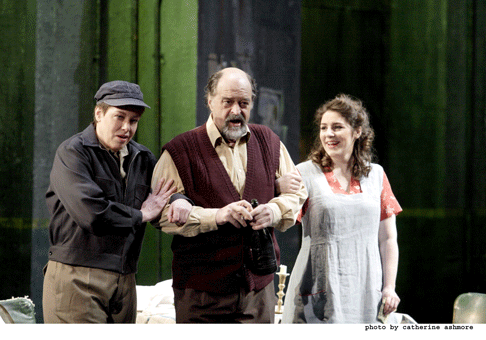 Nina Stemme as Leonore, Kurt Rydl as Rocco and Elizabeth Watts as Marzelline
Nina Stemme as Leonore, Kurt Rydl as Rocco and Elizabeth Watts as Marzelline
Florestan isn’t easy to cast. He’s an unusually charismatic figure, even more a symbol than a man. He’s so dangerous that he must be kept in solitary in the deepest, most secret dungeon. Again, Beethoven’s abstract music offers clues. Tenor voice, as a deliberate symbol of purity against a dank, dirty background. That’s why Beethoven, normally skimpy with stage directions, specifies a well and piles of rubbish. The vocal part sits high in the register because it represents an alternative to the other male parts, all written for low bass baritone. Florestan should, ideally, shine with glowing light, standing out from the darkness around him.
Since there have been a few wonderfully lustrous Florestans in recent years, such as Jonas Kaufmann, most others suffer in comparison. Endrik Wottrich is adequate, especially given that this unimaginative production asks for nothing more. Perhaps he’d be more inspiring in a production that made more of Florestan’s alluring charisma. Here, he’s not expected to be more than stock character.
Willard White is an impressive Don Fernando. The part is written for big, compelling voices, though significantly, there’s little call for psychological complexity in his music. Don Fernando is a plot device as much as a person. Maybe good kings appoint good ministers, but history has shown that that’s not something we can count on. Again, Beethoven is commenting through music rather than through words. Similarly, Don Pizarro’s music reflects repression, but John Wegner, fortunately, makes more of it than simplistic villain.
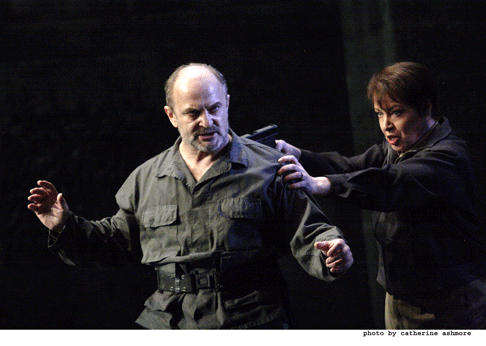 John Wegner as Don Pizarro and Nina Stemme as Leonore
John Wegner as Don Pizarro and Nina Stemme as Leonore
Kurt Rydl is a good solid Rocco, also vocally capable of conveying more than he’s asked to do in this production. The “gold” aria is important as it delineates Rocco’s personality. He’s not materialistic per se, but pragmatic. Not evil enough to kill Florestan, but weak enough to let Don Pizarro do the dirty work. Despots don’t get want they want without “innocent” followers. Elizabeth Watts’s Marzelline is charming, but again barely developed in stage terms. It’s a waste of her very considerable talents as singer and actress. She’s capable of much more. Perhaps Flimm’s too concerned with the trappings of marriage, like bouquets, rather than the spirit of marriage, which is what motivates Leonore.
It says a lot about this production that one of the most successful characters is Steven Ebel’s Jaquino. Left pretty much to his own resources by the nominal Personeregie, Ebel creates the role on his own. Though the part is relatively small, Ebel’s Jaquino comes over as fully thought through and convincing. In his own way, Jaquino is a male counterpart to Leonore. Both are faithful in love, both unfazed by difficult situations. Jaquino’s role is to Leonore’s, a recapitulation of a main theme. Again, Beethoven’s clues lie in the music, not just words.
The choruses in Fidelio are important because they represent the wider world, as opposed to the isolated charcaters in the main roles. The Royal Opera House Chorus is always very good. The voices in the chorus “O welche Lust” were very well balanced, so the effect of sound moving across the ensemble was well realized. The big choruses at the end were stunning. “Heil sei dem Tag, Heil sei der Stunde” sounds like chorale. Commitment expressed with quasi-religious fervour. At last the stage is lit brightly and gloom dispelled. But Flimm places neatly dressed wives and children in the chorus. But while Fidelio celebrates loyalty in marriage, it isn’t really about family, per se.
Sir Mark Elder replaced Kyril Petrenko as conductor on short notice. Elder is nearly always good and reliable, but this time the pace was sluggish, textures spread too far and without much sense of form and dynamics. Maybe the lacklustre production was getting to him as well. Fidelio is so much more than literal narrative. Stripped of conceptual context, it’s nullified, as music as well as theatre. “Wahre Liebe fürchtet nicht.” True love can’t be suppressed. Flimm’s lumpen production proves that literalism kills veracity.
Anne Ozorio
image=http://www.operatoday.com/2471ashm_597-STEMME-AS-LEON.gif
image_description=Nina Stemme as Leonore [Photo by Catherine Ashmore courtesy of The Royal Opera]
product=yes
product_title=Ludwig van Beethoven: Fidelio
product_by=Steven Ebel: Jaquino; Elizabeth Watts: Marzelline; Nina Stemme: Leonore; Kurt Rydl: Rocco; John Wegner: Don Pizarro; Prisoners: Ji Hyun Kim; Dawid Kimberg; Florestan: Endrik Wottrich; Willard W White: Don Fernando. Sir Mark Elder: Conductor; Orchestra and Chorus of the Royal Opera House; Renato Balsadonna: Chorus Director. Jürgen Flimm: Original Director; Daniel Dooner: Revival Director; Robert Israel: Set Designer; Florence von Gerkan: Costumes; Duane Schuler: Lighting.
product_id=Above: Nina Stemme as Leonore
Photos by Catherine Ashmore courtesy of The Royal Opera
April 3, 2011
Florian Boesch, Wigmore Hall
This time the focus was on songs written between 1870 and 1880. It’s a transitional period, dominated not by the unification of Germany but by Richard Wagner. Wagner’s impact was overwhelming. Intensely loved or loathed, his influence redefined the terms of art song. Boesch and Martineau chose a programme based on Brahms, Liszt and Hugo Wolf, to illustrate different responses to Wagner’s presence.
Brahms was an intimate of Eduard Hanslick, so he was somewhat immune. Yet one might be tempted to read Wagner’s hothouse passions into Brahms’s 8 Lieder und Gesänge op 57, as Susan Youens mentions in her programme notes. “All of these poems”, she writes, “are intensely erotic, and some of Brahms’s prissier contemporaries were offended…But the red thread we trace through these 8 songs is that of a lover who must contain his sexual desire without ever knowing whether his patience will be rewarded”.
In “Unbewegte laue luft”, (op 57/8) the heaving bosoms in the text indicate what “heavenly satisfactions” are in store, but the music itself is more restrained. Brahms seems more interested in somnolent Nocturne than erotic excess. The piano part develops like slow footsteps, each third chord in downward tread. Brahms depicts the fountain’s ripples and increases the tempo as the poet speaks of meeting his beloved. Fischer-Dieskau’s version of this song is decidedly chaste. Boesch infuses it with more personal intimacy, but the mood is still much deeper than lust.
What Wagner might have made of these poems by Georg Friedrich Daumer! In “Die Schnur, die Perl’ and Perle” (op 57/7) a pearl necklace “weigt sie sich so fröhlich”, rocks happily on the breast denied to the lover. Brahms doesn’t overextend his hand, so to speak. Boesch is discreet, warming the words gently, without exaggeration. Indeed, the most “Brahmsian” of these songs is “Es träumte mir” (op 57/3) almost a miniature, so delicate is its mood. Boesch almost whispers the repeat “Es sei ein Traum”, and Martineau’s piano expresses what words cannot say.
Boesch and Martineau also performed a mixed group of Brahms songs which enhanced Brahms’s aesthetic restraint. “Mondenschein” (op 85/2, Heine) came over with the reverence of a prayer. Brahms’s God resided in nature. More images of coolness, stillness and depth. In “Dein blaues Auge” (op 59/8) the beloved’s eyes are “as limpid as a lake, and like a lake so cool”. Boesch sings with such lucidity that the chill feels calm and sane. Not Tristan und Isolde. In “O kühler Wald “(op 72/3), “in Schmerzen schlief der Widerhall, die Lieder sind verweht”. Even an echo falls silent, and songs have blown away. Brahms could not have created Seigfried, talking to the birds.
Liszt’s connection to Wagner was obviously more complex. For a composer who was by instinct a pianist, Liszt makes great efforts to engage with words rather than succumb to pianist flourish. Gebet (S331) is a prayer, half spoken, the vocal part undecorated. As the penitent submits himself to God, the piano introduces a change of mood. At the end, Boesch sings “Mir wird so leicht, so leicht”, each phrase separated for emphasis. It’s as if he’s connecting to a spiritual presence we cannot see.
Hugo Wolf worshipped Wagner, and indeed managed to get into Wagner’s hotel to meet his hero, the way teenage rock star groupies might do. Boesch and Martineau chose Wolf’s earliest published songs, to texts by Heine, written when he was around 17. The poems offer dramatic possibilities - ships with great black sails in stormy seas, a shadow stalking a party, Hussars blowing trumpets. Already you can detect the germ of Wolf’s later vignettes. Not for nothing was Wolf called “The Wagner of the Lied”. Because these songs are so early, they need to be performed with particular care, and often don’t get the treatment they deserve. Boesch and Martineau take them seriously, and make them wholly convincing.
Two other composers were included in this programme. Zdeněk Fibich, much influenced by Wagner and the German side of his upbringing, wrote the opera Šárka which still sometimes surfaces in performance. In this recital, he was represented by Loreley a song to Heine’s text. It’s set dramatically, welling waves and wild, almost contrapuntal crescendo — a melodrama in miniature.
Friedrich Gernsheim (1839-1916) is much less familiar. Apparently he had connections to Brahms, and wrote mainly non-vocal music. Boesch and Martineau chose two songs (also Heine), Es war ein alte König and Es fällt ein Sterne herunter. Both attempt to dramatize the songs to a great degree — falling starlight figures in the piano part, for example. Martineau, however, stops them from feeling heavy handed, and Boesch stresses the lilt in words like “Apfelbaume” to liven the mood.
Intelligent encores, too, with a nod to the future of Lieder. Wolf’s Anakreon’s Grab (1890) and Brahms’s Da Unter im Tal (1894), proof yet again that simplicity and restraint can be exquisite.
The concert was recorded for broadcast on BBC Radio 3 online and on demand, later this Spring. If you hear strange ringing on the recording, it’s a mobile phone which rang at least four times. Accidents happen, so I won’t get irate. But it’s a reminder to switch off and double check every time without fail.
Anne Ozorio
image=http://www.operatoday.com/Boesch-Florian.gif
image_description=Florian Boesch [Photo by Stefan von der Deken]
product=yes
product_title=German Song Decade by Decade 1870-80
product_by=Florian Boresch, Malcolm Martineau. Wigmore Hall, London, 30th March 2011
product_id=Above: Florian Boesch [Photo by Stefan von der Deken]
Tosca, Palm Beach
In a representative case of truth at least rivaling fiction, there were dime-novel circumstances revolving around the play even before “the most famous actress the world has ever known” took the stage, the first Floria Tosca.
For one thing, the whole of the thing was set under the specter of legal issues – another author claimed that Sardou had cribbed the story (those days in theater circles, this was not an altogether uncommon accusation). The show would go on. Bernhardt saw to this herself as partial financier; she rented the theater where the play would debut in 1887.
The plot twists further when Bernhardt learns Sardou made arrangements to have another actress play La Tosca in the stateside premiere. Bernhardt’s threats to desert probably rang hollow; she was overinvested; the theater and the man (her lover) playing Baron Scarpia were hers. Bernhardt’s eventual change of heart aligned her with a calamity of fate, one joined to Floria Tosca’s own. Touring the play in Brazil, she injured herself in performance and eventually lost a limb. La Tosca, as you know, in the hands of Giacomo Puccini, would become the opera Tosca.
There were no such fractures in Palm Beach Opera’s Tosca (seen March 25th). Breaks of the dramatic variety, however, did happen.
It is unclear whether Director Massimo Gasparon’s concepts or the execution of these were faulty. One thing is clear, the acting of the principals tended towards predictable and slack, and in some cases limited in scope. Scarpia’s assault on Tosca is a case in point – more like timid mud-wrestling, the two seemed unsure of how to go about taking the actions of their respective motivations.
The troublesome stage activities seeped into the music and into the pit. Maestro Bruno Aprea showed the bearings of a trooper; through tripped-up entrances and marred text, the conductor mouthed along with singers and kept the music flowing – slowly. What is more, the orchestra pulled out very rich timbres and evenly wound textures. This instrumental balance gave way to the most sprawling soundscapes in act one: for the entire scene of Angelotti’s reappearance and the soaring lines of the duet.
The chorus – prepared by Greg Ritchey – turned in a strong vocal performance in the “Te Deum” and some often over-shadowed musical bits were gleaned from Tosca’s recital.
There were moments when Chiara Taigli seemed miscast in the role of Tosca, her voice a hair light in the middle, with but a touch of steel at top. Her “Vissi d’arte” was labored as Aprea seemed to take things slower still. At the word “assassino” in the second act, Taigli’s stage manner turned more sure and the use of her hands in the final act duet was striking.
Tenor Riccardo Massi has had some important engagements overseas of late. As Cavaradossi here, Massi’s easy high notes complimented a weighted sound that sped through “E lucevan le stelle.” Massi demonstrated he could sing a legato line though there were few instances of him doing it.
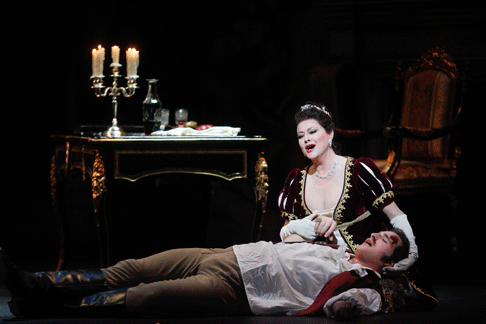 Chiara Taigi as Tosca and Riccardo Massi as Cavaradossi
Chiara Taigi as Tosca and Riccardo Massi as Cavaradossi
Claudio Sgura appeared to be taking cues from Tito Gobbi’s acting grab bag; the baritone mainly used his eyes to convey wickedness as Scarpia. Sgura’s singing was one-dimensional, an attractive dimension though it is.
Matteo Peirone returns to PBO as Il sagrestano, with a big moment corralling choir boys just before the “Te Deum.” Mathew Burns’ played a woozy Angelotti. Young Artist Evanivaldo Correa Serrano’s Spoletta was obliging to his master Scarpia. With a sharp turn and genuflection towards his liege, as Sciarrone Young Artist Kenneth Stavert’s actions were as if half-mocking Scarpia. Gasparon has the Shepherd Boy – on this night Young Artist Greta Ball, trying her darndest to sing out of vibrato – sitting on the ramparts of Castel Sant'Angelo and shooed away by guards after his paen to the morning.
PBO borrows these sets for Tosca from Sarasota Opera; they were created by Sarasota’s resident scenic designer David P. Gordon. Gordon’s take on Castel Sant'Angelo includes a backdrop (lit by Joseph R. Oshry) view of St. Peter’s Basilica and Vatican City.
Taigli’s suspenseful swinging of her cape before diving from Sant’Angelo’s parapets ended Tosca in better dramatic form than had been the night’s pattern. Incidentally, it was on this fall that Bernhardt shattered her right knee in La Tosca.
Robert Carreras
image=http://www.operatoday.com/ToscaTaigiSgura.gif image_description=Claudio Sgura as Scarpia and Chiara Taigi as Tosca [Photo courtesy of Palm Beach Opera] product=yes product_title=Giacomo Puccini: Tosca product_by=Tosca: Chiara Taigi (3/25 and 3/27), Tiffany Abban (3/26 and 3/28); Cavaradossi: Riccardo Massi (3/25 and 3/27), Warren Mok (3/26 and 3/28); Scarpia: Claudio Sgura (3/25 and 3/27), Stephen Powell (3/26 and 3/28); Sacristan: Matteo Peirone; Angelotti: Matthew Burns; Sciarrone: Kenneth Stavert; Spoletta: Evanivaldo Correa Serrano. Conductor: Bruno Aprea. Director: Massimo Gasparonpestra and Chorus; Greg Ritchey Chorus Master. product_id=Above: Claudio Sgura as Scarpia and Chiara Taigi as ToscaPhotos courtesy of Palm Beach Opera
April 1, 2011
From the Field to the Stage
Robinson, nicknamed “Massive” during his run as a two-time All-American offensive lineman at The Citadel, has made a successful transition to an opera career; Robinson is now one of the most pursued bass performers of today.
"I don't think music and athletics are so far apart," Robinson said. "It takes a lot of intestinal fortitude, a certain resilience that you learn in sports and in life."
Currently, Robinson is performing in the Florida Grand Opera’s production of Don Giovanni, which opens April 16th in Miami.
Robinson plays the role of the Commendatore, the father of Donna Anna, who is killed by Don Giovanni in Act I but then returns in Act II as a ghost to drag Don Giovanni to hell.
Characterized by his commanding stage presence and a booming bass to match, Robinson is well suited for the part, serving as the first and only Commendatore to date in the John Pascoe production seen previously in the Washington National Opera and Dallas Opera. Robinson has conquered the difficult role both musically and physically.
In Act I the role calls for Robinson to underplay what he was naturally blessed with, a strong powerful voice. As the Commentador dies and is holding on to his last breath his voice is called to be performed chopping and monotonous, traits opera performers are trained not to do.
His masterful voice takes full charge of Act II. As the Commendatore’s spirit Robinson must transform into the most powerful and dominant voice on the stage, taking over the scene, which he does with a truly powerful finesse.
Don Giovanni is famous for its fight scenes, which also add a physical challenge, as the actors have to sing following tiring duels, such as that between the Commendatore and Don Giovanni himself. This is where Robinson draws his experience as an athlete, noting that training for both are one in the same.
“Being a former athlete, training for football involves certain exercises that require physical agility,” Robinson explains, comparing his former football practices to strenuous fight choreography and voice rehearsals.
When Robinson graduated from The Citadel, he had his sights set on the corporate world and moved to Boston to pursue his goals. However, upon arrival Robinson signed up for singing classes at the New England Conservatory and ended up diving head first into the opera scene. It didn’t take long for his bass voice to be heard by the director of Boston University’s music school. Captivated by his unique voice, she advised Robinson that he should definitely consider making opera his career.
Robinson immediately auditioned at the Boston University Opera Institute, won a full scholarship and has never looked back. He has gone on to complete the Metropolitan Opera Lindemann Young Artist Development Program and it was there that Robinson made his stage debut in Fidelio.
Robinson has since performed in numerous other productions at the Met, including The Magic Flute, Aida, Les Troyens and Salome. He has also worked with multiple opera companies, including the Opera Company of Philadelphia, Seattle Opera, Boston Lyric Opera, and the Wolf Trap Opera.
Liana Cole
image=http://www.operatoday.com/Morris_Robinson.gif image_description=Morris Robinson [Photo by Lisa Kohler] product=yes product_title=Morris Robinson commands Don Giovanni product_by=By Liana Cole product_id=Above: Morris Robinson [Photo by Lisa Kohler]